The air is a space, an object, a threat, a myth, a weapon, a common. While it might have once been forgotten, as feminist philosopher Luce Irigaray claims, the air is a space of great attention today.1 For scholars in disciplines such as human geography or anthropology, it has become a prolific in capturing atmospheric conditions that bring together the meteorological and affective, a conceptual tool to help “deterrestrialize” anthropological thought, and a thinking method in itself, of being in suspension.2 Other scholars have recently explored how the air has become a cultural object through history, the space of war, of governance, and of environmental activism, among others.3
No matter how conceptually useful and seductive the air is, by making a case of its specificity and distance, we risk treating the air as something “out there,” and thus preventing individual and collective responses. That said, the air just above the ground, the troposphere, the messy space where we breathe and live along with other beings, is not a heroic space to be conquered or a space of great disasters, but one of routines. It is an air that is different in every corner and circulates in unexpected ways, where the differences of environmental injustice are more palpable. We cannot escape this air. It is the air that comes into our body through our lungs. It is the air in which dogs bark, where bees fly and spread pollen. It is the air that is part of our urban ecologies and territories, filling our open, public spaces. It is not just this though. It is also the air of capitalist and neoliberal accumulation, the disposal space of industrial, technological, and farming production systems. It is the air of inequality, injustice, and of slow and invisible violence.4 As a space of accumulation itself, it retains heavy metals released by factory chimneys and toxic human-made chemical compounds. It also suffers from an excess of its own components, like carbon dioxide, carbon monoxide, nitrogen dioxide, or formaldehyde, just to name a few, that are released by industry, traffic, and consumption. The polluted air is one that contributes to producing alter-lives, chemically altered lives and beings.5
This thin section of the atmosphere has materiality, yet one which we cannot normally see with our eyes. To study it, the infrastructures, devices, practices, and bodies that make the air visible become an intrinsic part of it. Science accounts for this accumulation through numbers and concentrations, but this account only provides for one condition of pollution, as well as suggesting technoscientific stories as “solutions” concerned with cleaning it through massive geoengineering projects. In a similar manner to climate change, numbers become too abstract and detached from reality for people engage with them in meaningful ways. As Rob Nixon claims, “the scale of the climate issue can make it feel unmanageably abstract. I believe it’s the role of artists and gifted climate communicators to help bring home the perturbing changes, to make them visceral, textured, intimate.”6 How, then, can we bring home the air’s accumulated excess, make it visible and sensible with alternative modes to existing monitoring practices, and tell other stories?
Attentive speculation
Paying attention to existing infrastructures and unpacking their material, social, and political assemblages provides an idea of what they put at stake, how they articulate certain narratives, and ultimately, the effects of their design decisions. However, studying infrastructures poses a methodological challenge, as infrastructures tend to be invisible.7 Instead of studying them only when they break, which is when they become visible, we can perform an “infrastructural inversion,” meaning to look at the infrastructures we do not see, and “think with care,” or focus on what has been neglected or forgotten, left out through choices, histories, or policies.8 Within this context, speculation becomes a strategy to imagine or practice alternative futures, to explore other possibilities, to not take for granted what there is and reject the common assumption that there is nothing to be done to care for the environment.9 Thus, “attentive speculation” is a design method to unpack the invisible and the black-boxed, and by asking “what if” aims to re-articulate what exists in ways that might suggest other narratives or other futures, or what Isabelle Stengers describes as:
In short, histories that bear on thinking together as a work to be done. And we need these histories to affirm their plurality, because it is not a matter of constructing a model but of a practical experiment. Because it is not a matter of converting us but of repopulating the devastated desert of our imaginations.10
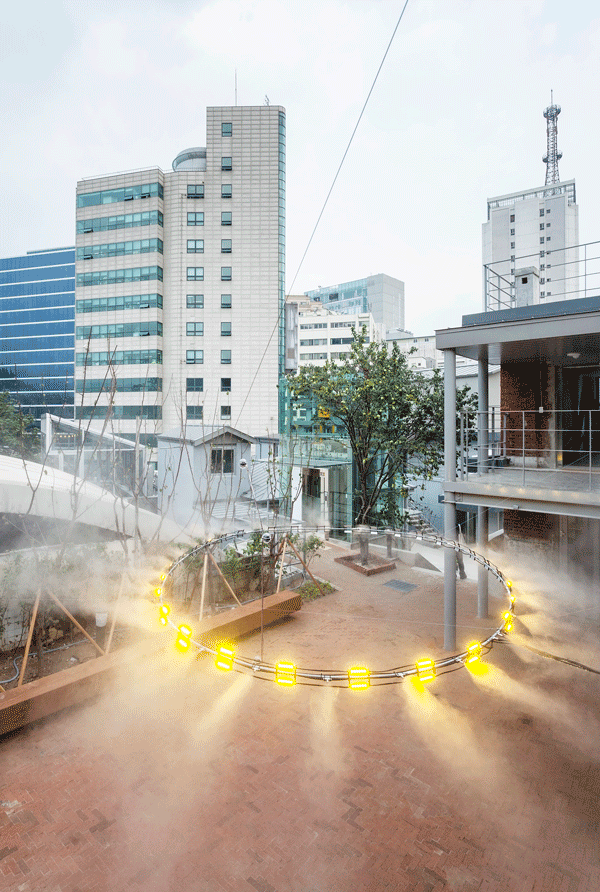

In the Air/C+arquitectos, Yellow Dust, Seoul, 2017. Photo: Daniel Ruiz.
Fussing aims
Air pollution models and institutional visualizations are developed to predict air quality so that people can adjust their daily activities accordingly. By making us look into the future, these images distract us from looking at the past, at the histories of pollution. What if instead of aligning with positivist understandings of information—where knowledge produces individual behavioral change—we pay attention to the collective effects of pollution? This shifts the aims of the visualization from “solving” individual problems to “fussing” with air pollution, where “the very strength of [making] a fuss is not to represent the True, [but] rather to be witnesses for the possibility of other ways of doing what would perhaps be better.”11
Attentive speculation is a method of unpacking, speculating, and constructing environmental infrastructures. Yellow Dust (YD), an example of this method, is a measuring and visualizing infrastructure which suggests a form of design and inquiry that expands the ways of relating to toxic air.12 By not trying to solve the problem but rather fussing with the aims of visualization, YD makes the problem of air pollution visible, present, and uneven. It looks at the history of pollution to recognize places that have always had bad air quality, and connects environmental vulnerability with spatial and social factors.
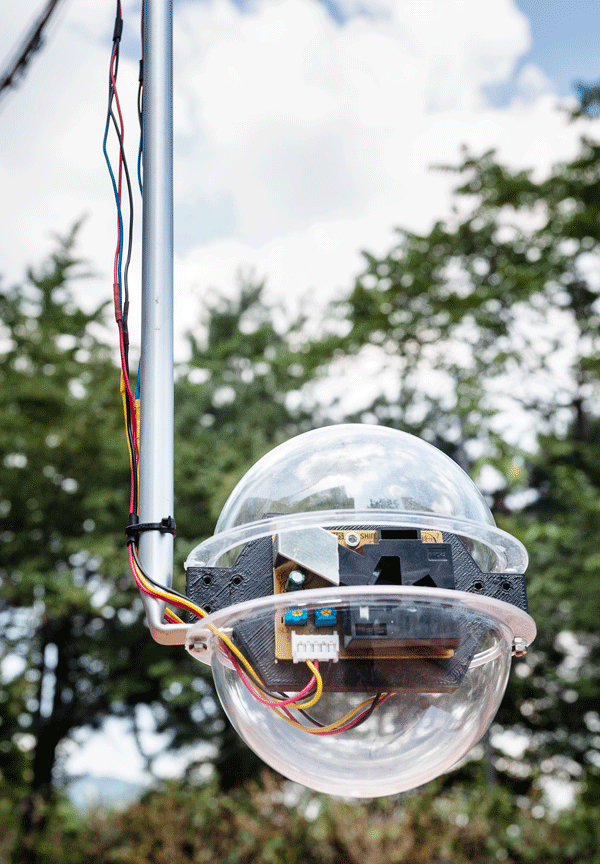

In the Air/C+arquitectos, Yellow Dust, Seoul, 2017. Photo: Daniel Ruiz.
Infrastructuring location
There is often a disconnect between the place where the air is being measured (the sensor) and where its data is seen (a screen). YD not only makes the air whose quality is in question visible in situ, but also registers the very specificity of its site.13 YD collects data from its immediate surroundings using two low-cost sensors. This data differs from available data from the Seoul Metropolitan Government, as the closest official monitoring station is still far from the public space in which YD was located.14
YD aims to contribute to advocacy not by providing datasets, but by increasing the ways in which a specific location is managed and known. This brings an ethical question to bear: aside from generating awareness and potentially leading to direct action, localizing pollution might have adverse effects on the lives of its local community. Crime maps, for instance, have contributed to neighborhoods being stigmatized, with property prices decreasing and increased isolation, all without the problem of criminality being solved. We have to think carefully not only about where the air should be made visible, but also about its potential side effects. For while YD measures and makes the air visible in the same place, it is not necessarily a demonstrational device that indicates how to reduce air pollution. It aims to be an instrument that produces connections, generates questions, and produces provocations; one that brings humans and more than humans into a cosmopolitical experiment.15
Airing pollution
Of all the gases and particles that compose the air, which ones should be made visible? Components with the highest concentrations, or the most controversial? Local emissions or transboundary ones? Paying attention to what matters about pollution and thinking which of the particles and gases and their effects are worth making visible is itself a form of making air pollution a matter of concern, of airing the issue of pollution. This ultimately entails discussing not only its concentrations, but also its politics.
YD shifted the conversation from “how much” to “who is emitting.” Particulate matter concentrations are usually high in Seoul, but the government and the media attribute them to Hwangsa (“yellow dust” in Korean): transboundary fine soil particles that are carried by the wind from Mongolia and Northern China mostly during the spring, and that bring with them other types of industrial pollutants. Although there are frequently high levels of particles created by local sources, Hwangsa creates a sense of matter out of place, of a non-human invasion that reinforces the distinction between local and foreign air, and has triggered legal and political international battles.16
YD aimed to unsettle the idea of the yellow dust as a foreign and unwanted entity. By identifying whether there was local particle pollution in Seoul’s atmosphere in the months when Hwangsa was less present, YD helped to locate oneself within conditions that are simultaneously local and planetary. In reference to Hwangsa, YD’s mist was colored with yellow light, putting this cultural bias to work. This moves away from the correlation usually established in visualizations between air pollution and the Air Quality Index, a color gradient that correlates particle concentrations with their effect on human health, and where yellow means below the legal limits.17 The reason for avoiding this relation is to find other modes of attending to the air beyond human health. This is not to say that human health does not matter, but on the contrary: it takes into consideration that every body—human or more than human—reacts to pollution differently. To account for all these diverse sensitivities, YD does not specifically address any specific body, and focuses on what touches the collective; the social effects of pollution.


In the Air/C+arquitectos, Yellow Dust, Seoul, 2017. Photo: Daniel Ruiz.
Dissipating data
In scientific visualizations, diverse elements are treated in the same way: temperature, precipitation, or air particles, for instance, all share the same type of graphs or pie-charts, with a label as the only differentiator. Their qualities and properties are not taken into consideration, leaving them as abstract entities. To engage differently with pollution, what if we paid attention to the material properties of our objects of research and play them out? What if their visualizations perform as the objects they re-present? Olafur Eliasson, in his Green River series, dyed parts of rivers with uranine, a non-toxic water-soluble dye used to test ocean currents, to make passers-by aware of their surroundings. HeHe’s Nuage Vert similarly projected a massive green laser onto the smoke coming out of a factory’s chimney to make citizens aware of pollution. Following this tradition, YD does not make data or emissions visible, but with a visualization that dissipates into the environment, the air itself.
If we take the air’s material conditions seriously, due to its fluidity and constant transformation, it is not possible to display data with resolution. Perhaps the air is an opportunity to move away from the endless thirst for resolution (both in sensing and visualizations) and find alternative forms of dealing with toxicity. Instead of de-codifying information, by dissipating data, YD suggests forms of attuning to toxicity, of recognizing or detecting it.
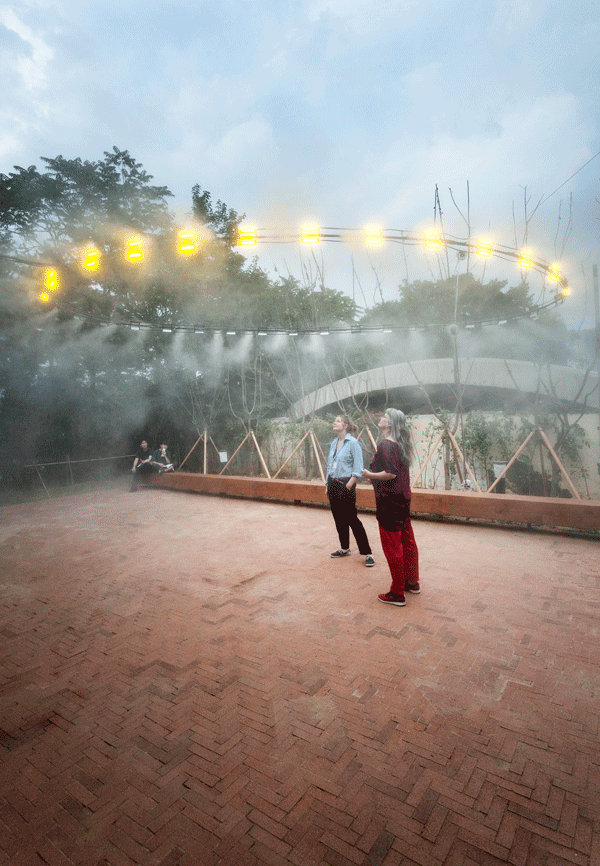

In the Air/C+arquitectos, Yellow Dust, Seoul, 2017. Photo: Daniel Ruiz.
Embracing matter
Materiality poses resistance to ideas. When designing an early YD prototype in 2008, I visited an atmospheric scientist. When I asked her how to “taint” the air, she responded furiously, saying that I had no idea what I was talking about, that it was not only absurd and difficult, but also illegal to release gases or particles into the air (despite the fact that factories do). Being unable to contribute to pollution brought other material properties and representational capacities of air to the fore, such as water, which brought new experiential and spatial opportunities.
Mist is visual but it can also be felt by other senses. It also alters the environmental conditions of a space. Mist blurred the edges of Fujiko Nakaga’s Pepsi Pavilion at the Osaka Expo in 1970. Mist was meant to serve as a display for art and information projections in Diller and Scofidio’s Blur Building for the Swiss Expo in 2002. In YD, mist revealed the constitution of the air that composed it, and contributed to expanding embodied encounters with data and the climatic effects of infrastructures.
Permeating experience
Studies on the impact of air pollution data in citizens have demonstrated that information does not necessarily produce behavioral change. In fact, quite often, it leads to indifference and even fear.18 Data requires interpretation, and scientific visualization formats require a certain visual literacy. Artistic or architecture projects like Andrea Polli’s Particle Falls (San José, 2010) or The Living’s Living Light (Seoul, 2009) have worked to create more visually-appealing and seductive encounters with data. Yet all these cases reinforce vision as the only way of knowing, relegating other senses to the realm of feeling. What if instead of making data visible, we make it sensible?
Water vapor creates a soft mist of humidity that can be experienced through breath and skin contact. It makes data permeable, democratizing the perception of air pollution and highlighting the unevenness of its effects. Only sensitive bodies sense pollution, but it is likely that more bodies sense humidity. With YD, on days of high particle concentrations (Hwangsa-related or not), several modes of sensing overlap: visual (the color of pollution and the color of the mist); skin-based (the humidity and the temperature of the mist); and the nose, eyes, or lungs (for particle-sensitive bodies). Water vapor can also alleviate the symptoms of asthma, so YD may also serve as a relief. Overall, it produces an overlapped—even excessive—sensorial experience. Thus, the de-coding of air pollution is not immediate, and it may take time for passers-by to be able to compare particle concentrations with earlier hours or previous days. It is an infrastructure that moves away from speed-of-information tropes, requiring time getting to know it and for bodies to become trained to sense different intensities.
Wetting urban space
Mist not only expands modes of sensing data, but also demands we pay attention to the conditions of the urban space. Wetting the data transforms the air’s temperature and humidity, which can be useful during the dry seasons of autumn and spring (during the wet season, as there is normally no air pollution, there would be no water vapor). The mist also “infrastructures” the urban space.19 What if an infrastructure monitors, makes visible, and remediates at the same time? By wetting the data, YD also wets the urban space, helping remediate particulate matter concentrations. As water deposits particles, the mist might reduce their concentrations in that specific location.
By wetting the data, it also becomes distributed across space and time in an untraceable way, creating a sort of atmospheric media that brings together technologies and urban conditions below the threshold of sensing.20 Media and the air become the same thing, elemental conditions that act like a chemical interaction, a milieu, and an environment.21 It is not possible to distinguish between the technology and the matter upon which it acts, as the infrastructure and what is sensed cannot be disentangled, nor even distinguished. The water vapor dissolves into the air, becoming one. Not only does the infrastructure become atmospheric, but it makes the air infrastructural by being the support of its own data, making itself visible.
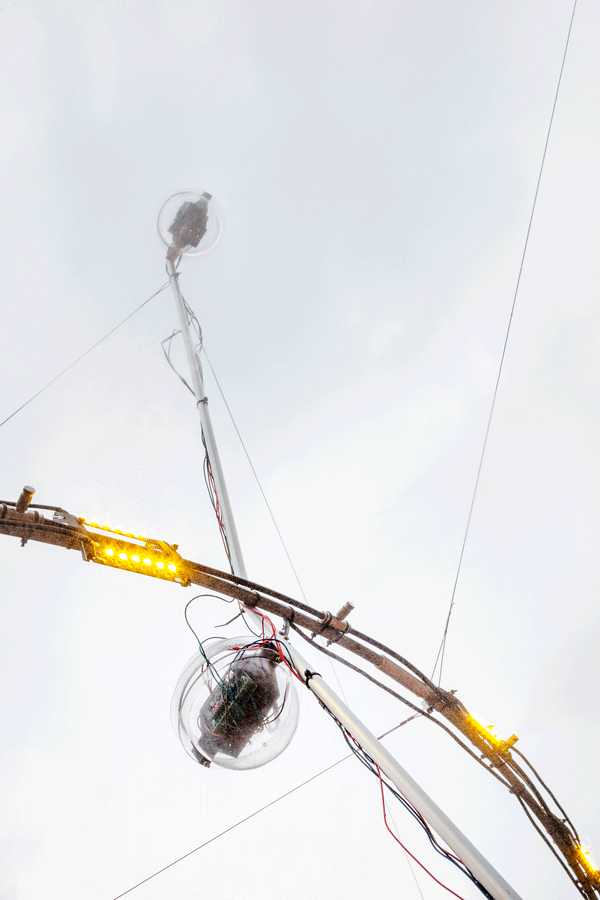

In the Air/C+arquitectos, Yellow Dust, Seoul, 2017. Photo: Daniel Ruiz.
Commoning infrastructures
Scientific and policy making air monitoring devices tend to be invisibilized and black boxed, focused exclusively on gathering the most accurate and stable data. Yet their invisibility is a problem, in that it reduces the possibilities for people to understand their performance, and the potential to intervene.22 What if we make not only the air visible, but also the infrastructure itself? What are the limits of visibilising an infrastructure?
YD revealed its own infrastructure—the steel cable supporting the water vaporizers, the sensors, the cables that channel the water, the LED lights, etc.—as well as all of the devices required for it to function: the water pump, the micro controllers, the Arduino, and the like. From an ecosystemic perspective, it also made visible what it takes to monitor and display air pollution information, through small water and energy meters that display its own consumption. YD politicizing its engagement engagement with the toxicity of the city by opening up its monitoring process and making its performance visible.23 Diagrams for its replicability were made available to make the project not only an infrastructure of the common air, but also an infrastructure for an expanded idea of the common, one that addresses alternative ways of being together.
YD and similar projects will not “solve the problem” of air pollution. To solve the problem of air pollution we need to stop economic growth, radically change the ways we use and produce energy, food, and manufactured products, just to begin with. YD also does not create a parliament where humans and more than humans come together. YD is an experiment to test if it can be an infrastructure for transition.24 It is a blurry, intimate space of cohabitation where we can imagine other relations with our urban ecologies and contribute to repopulating the devastated desert of our environmental imaginations.
Luce Irigaray, The Forgetting of Air in Martin Heidegger, trans. Mary Beth Mader (Austin: University of Texas Press, {1983} 1999).
See Derek P. McCormack, “Elemental Infrastructures for Atmospheric Media: On Stratospheric Variations, Value and the Commons,” Environment and Planning D: Society and Space, 2016, 1–20; Cymene Howe, “Life Above Earth: An Introduction,” Cultural Anthropology 30, no. 2 (May 25, 2015): 207; Timothy K Choy and Jerry Zee, “Condition-Suspension,” Cultural Anthropology 30, no. 2 (2015): 210–23.
See Peter Adey, Air: Nature and Culture (London: Reaktion Books, 2014); Peter Sloterdijk, Terror from the Air (Cambridge, London: The MIT Press, 2009); Mark Whitehead, State, Science & the Skyes (Oxford: Wiley-Blackwell, 2009); Thimoty Choy, “Air’s Substantiations,” in Lively Capital: Biothechnologies, Ethics and Governance in Global Markets (Durham: Duke University Press, 2010).
Rob Nixon, Slow Violence and the Environmentalism of the Poor (Cambridge, Mass: Harvard University Press, 2011).
Michelle Murphy, “Alterlife and Decolonial Chemical Relations,” Cultural Anthropology 32, no. 4 (2017): 494–503.
Rob Nixon, “Dead Metaphors, Dying Symbols and the Linguistic Tipping Point,” The Climate Change Project, September 5, 2018, ➝.
The networks of sensors, information panels, and apps that measure and attempt to make the air visible tend to be ubiquitous yet small, and often made invisible for political reasons. Nerea Calvillo, “Political Airs: From Monitoring to Attuned Sensing Air Pollution,” ed. Manuel Tironi, Max Liborion, and Nerea Calvillo, Social Studies of Science 48, no. 3 (2018): 372–388.
See Susan Leigh Star, “The Ethnography of Infrastructure,” American Behavioral Scientist 43, no. 3 (November 1, 1999): 377–391; Geoffrey C. Bowker, Science on the Run: Information Management and Industrial Geophysics at Schlumberger, 1920–1940 (Cambridge: The MIT Press, 1994); Maria Puig De la Bellacasa, Matters of Care: Speculative Ethics in More Than Human Worlds (Minneapolis, London: University of Minnesota Press, 2017).
See De la Bellacasa, Donna Haraway, Staying with the Trouble: Making Kin in the Chthulucene (Durham: Duke University Press, 2016), and many others. Speculation furthermore assumes a lack of closure and an uncertainty around the outcomes, that also requires other forms of evaluation. Michael Guggenheim, Bernd Kräftner, and Judith Kröll, “Creating Idiotic Speculators: Disaster Cosmopolitics in the Sandbox,” in Speculative Research. The Lure of the Possible, ed. Marsha Rosengarten, Martin Savransky, and Alex Wilkie (London: Routledge, 2017), 145–62.
Isabelle Stengers, In Catastrophic Times: Resisting the Coming Barbarism, trans. Andrew Goffey (Open Humanities Press, 2015), 132.
Haraway citing Desprets in Haraway, Staying with the Trouble, 130.
Yellow Dust was designed by In the Air/C+arquitectos (Nerea Calvillo with Raul Nieves, Pep Tornabell, and Yee Thong Chai). The project was commissioned and produced by the Seoul Biennale of Architecture and Urbanism 2017. with the support of Acción Cultural Española and an impact ESRC IAA grant from the University of Warwick and the Economic and Social Research Council (ESRC).
Precise measurement is essential for advocacy and environmental justice projects. Nicholas Shapiro, Nasser Zakariya, and Jody Roberts, “A Wary Alliance: From Enumerating the Environment to Inviting Apprehension,” Engaging Science, Technology, and Society 3, no. 0 (September 28, 2017): 575–602.
See ➝.
Steve Hinchliffe et al., “Urban Wild Things: A Cosmopolitical Experiment,” Environment and Urban Planning D: Society and Space 23 (2003): 643–58.
Mary Douglas, Purity and Danger: An Analysis of Concepts of Pollution and Taboo, Classics Series (London: Routledge, 1966).
David Shooter and Peter Brimblecombe, “Air Quality Indexing,” International Journal of Environment and Pollution 36, no. 1/2/3 (2009): 305.
Andrew Barry, Political Machines: Governing a Technological Society (London: The Atholone Press, 2001).
Anders Blok, Moe Nakazora, and Brit Ross Winthereik, “Infrastructuring Environments,” Science as Culture 25, no. 1 (January 2, 2016): 1–22.
Nigel Thrift, “Remembering the Technological Unconscious by Foregrounding Knowledges of Position,” Environment and Planning D: Society and Space 22, no. 1 (2004): 175–90.
Derek P. McCormack, Atmospheric Things: On the Allure of Elemental Envelopment (Durham: Duke University Press, 2018).
Anne Galloway, “Intimations of Everyday Life. Ubiquitous Computing and the City,” Cultural Studies 18, no. 2/3 (May 2004): 384–408.
Fernando DomÍnguez Rubio and Uriel Fogué, “Technifying Public Space and Publicizing Infrastructures: Exploring New Urban Political Ecologies through the Square of General Vara Del Rey,” International Journal of Urban and Regional Research 37, no. 3 (2013): 1035–1052.
Lauren Berlant, “The Commons: Infrastructures for Troubling Times,” Environment and Planning D: Society and Space 34, no. 3 (2016): 393–419.
Accumulation is a project by e-flux Architecture and Daniel A. Barber produced in cooperation with the University of Technology Sydney (2023); the PhD Program in Architecture at the University of Pennsylvania Weitzman School of Design (2020); the Princeton School of Architecture (2018); and the Princeton Environmental Institute at Princeton University, the Speculative Life Lab at the Milieux Institute, Concordia University Montréal (2017).
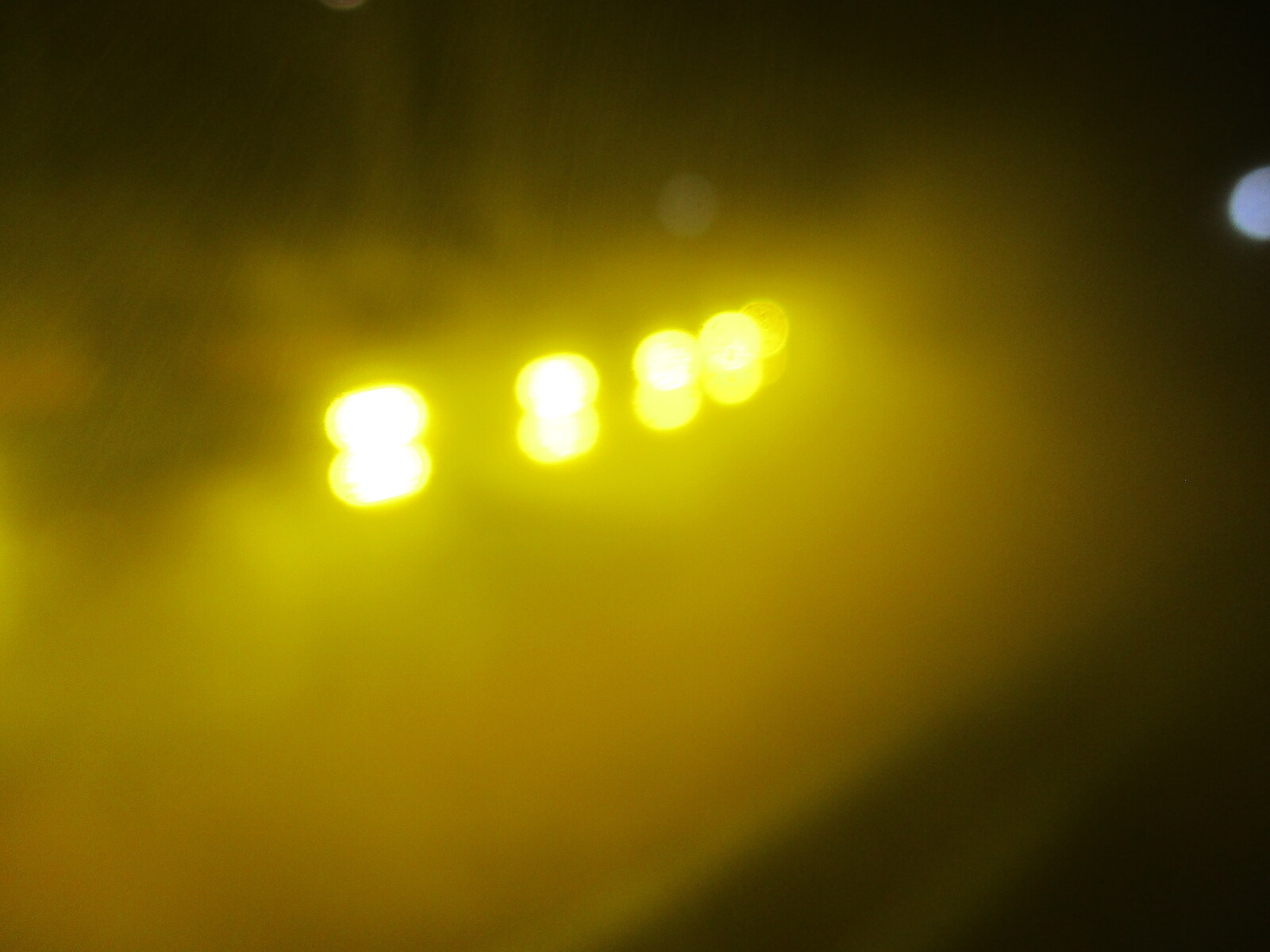






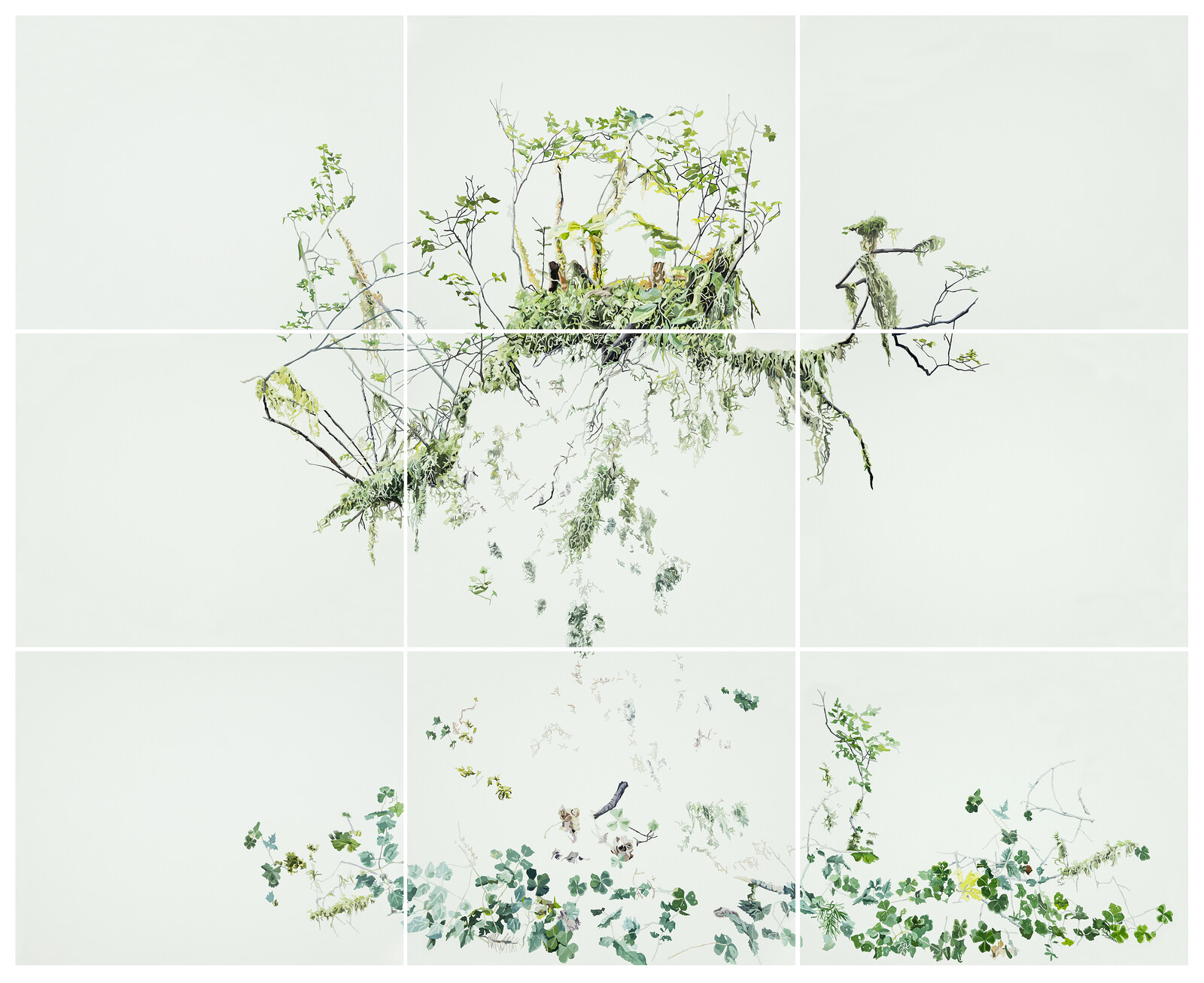
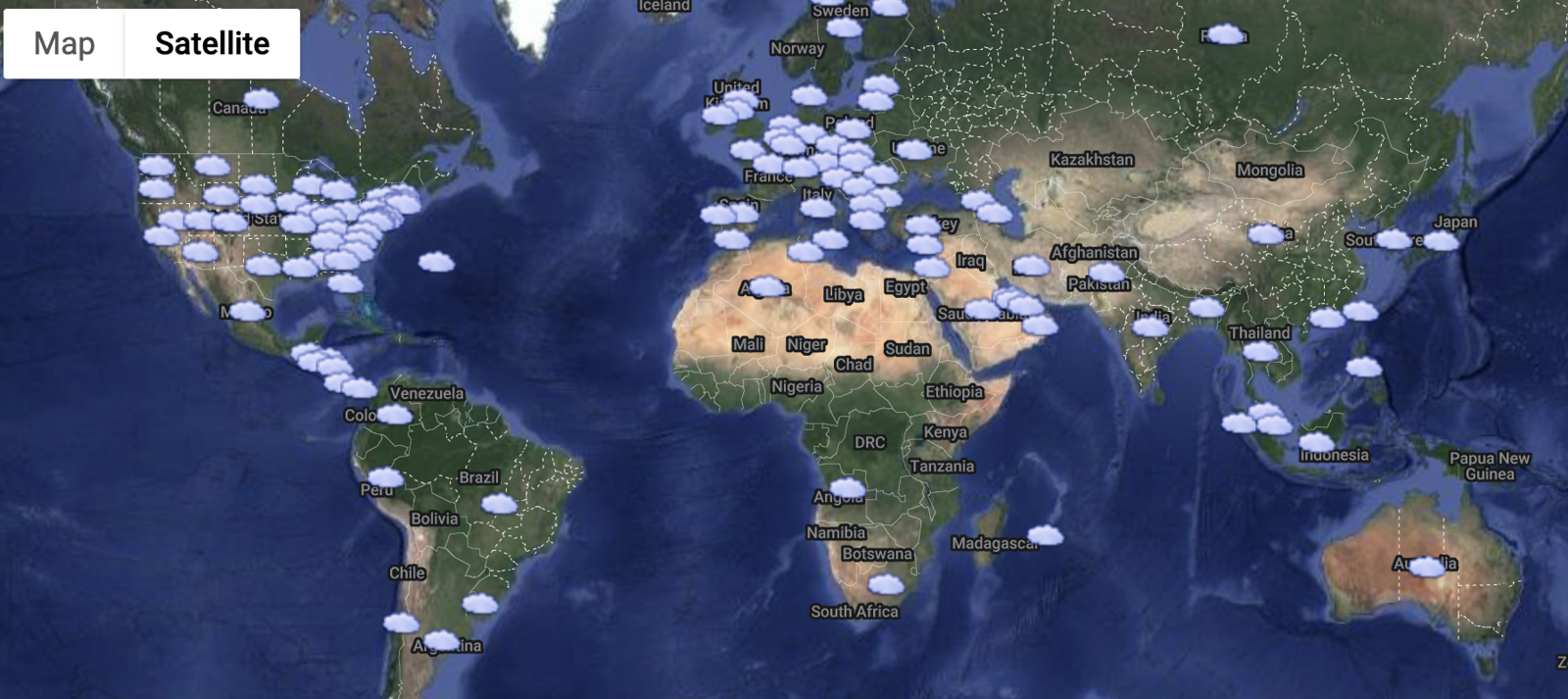
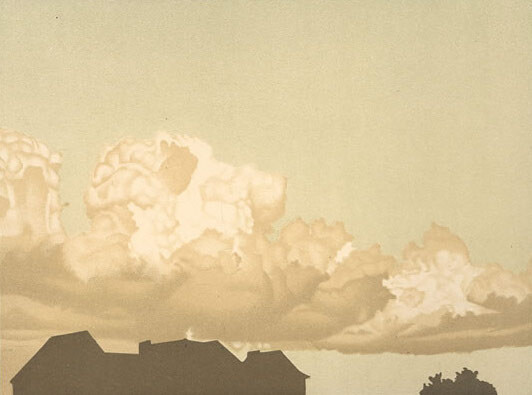
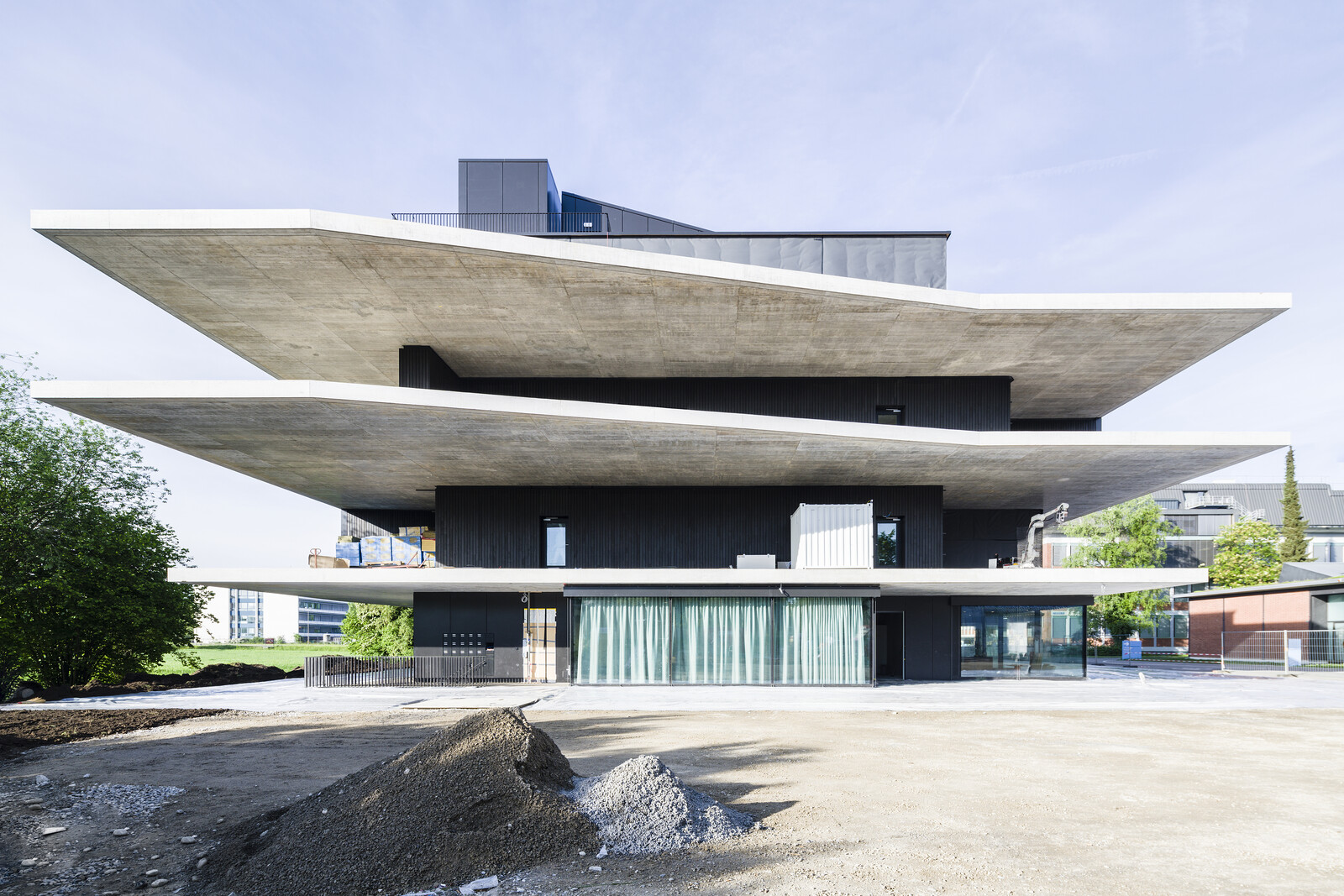

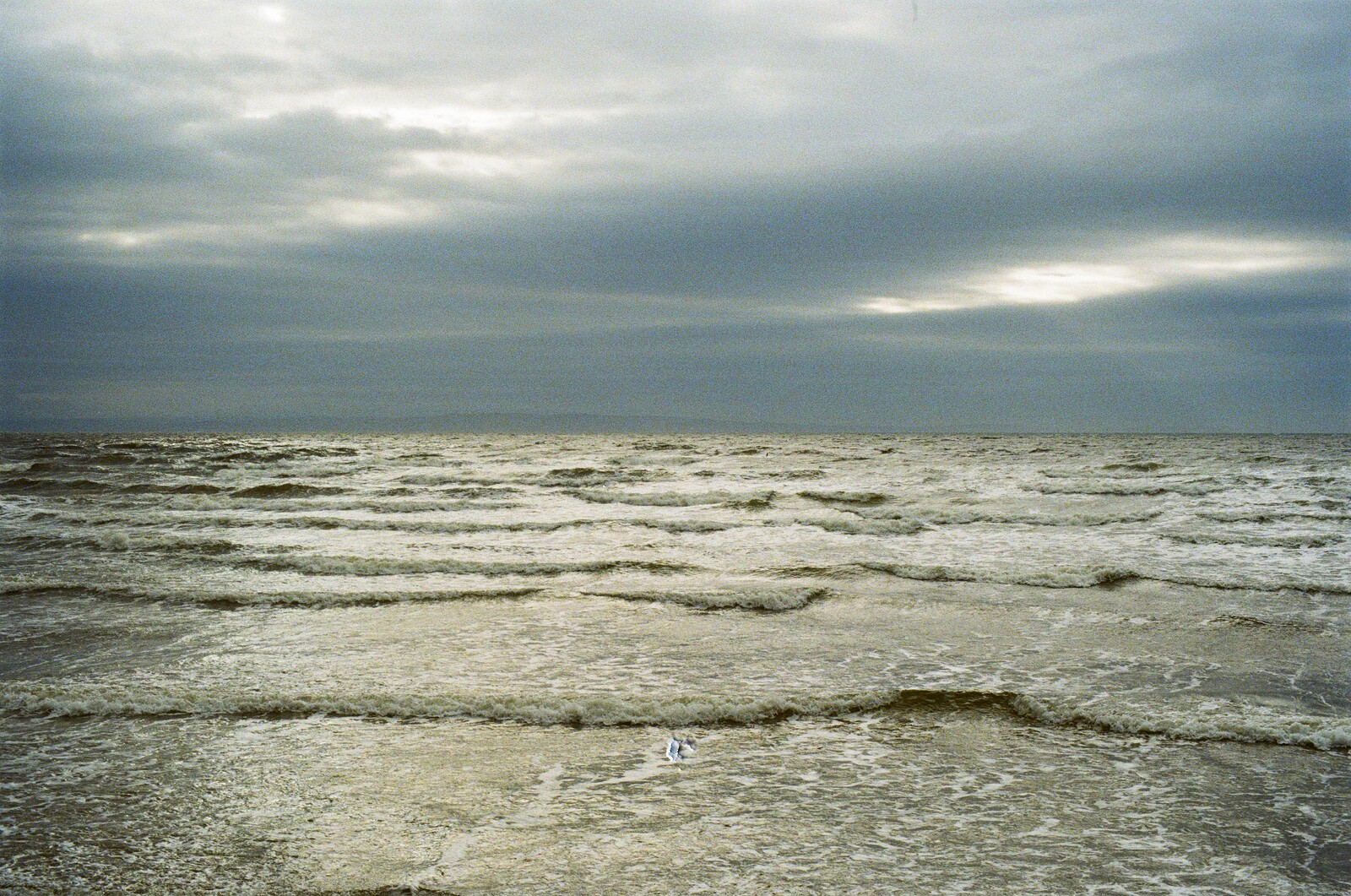
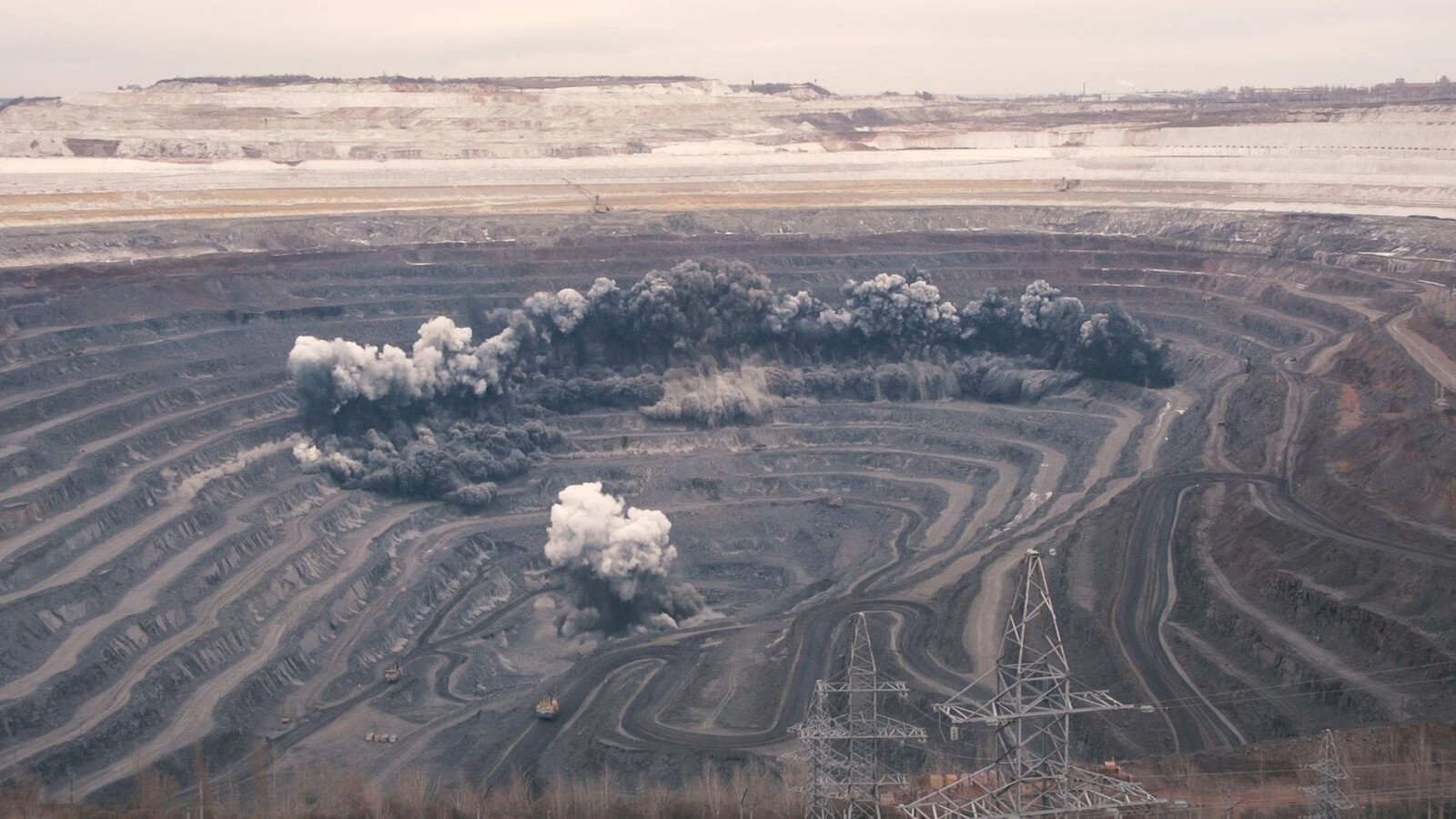
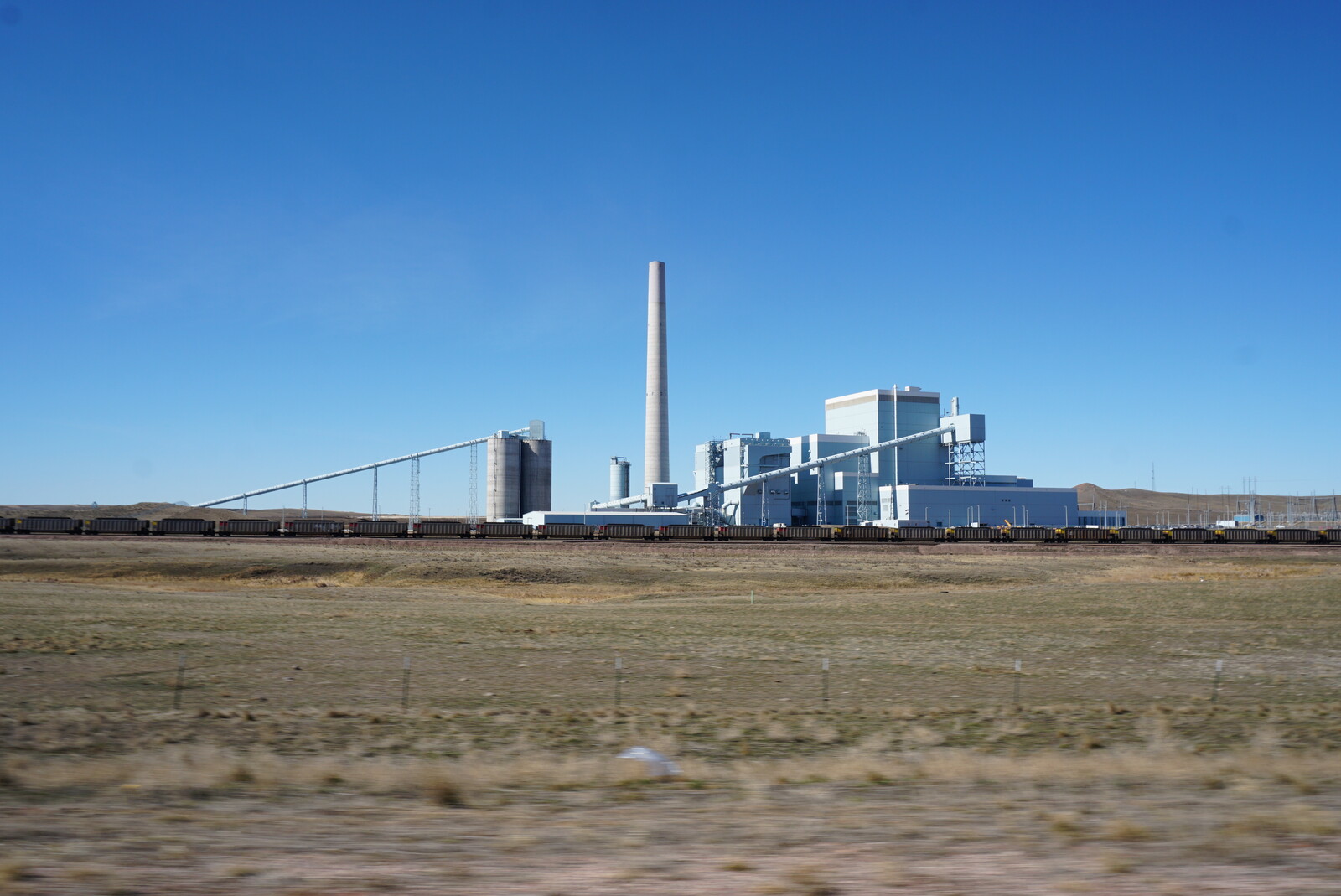
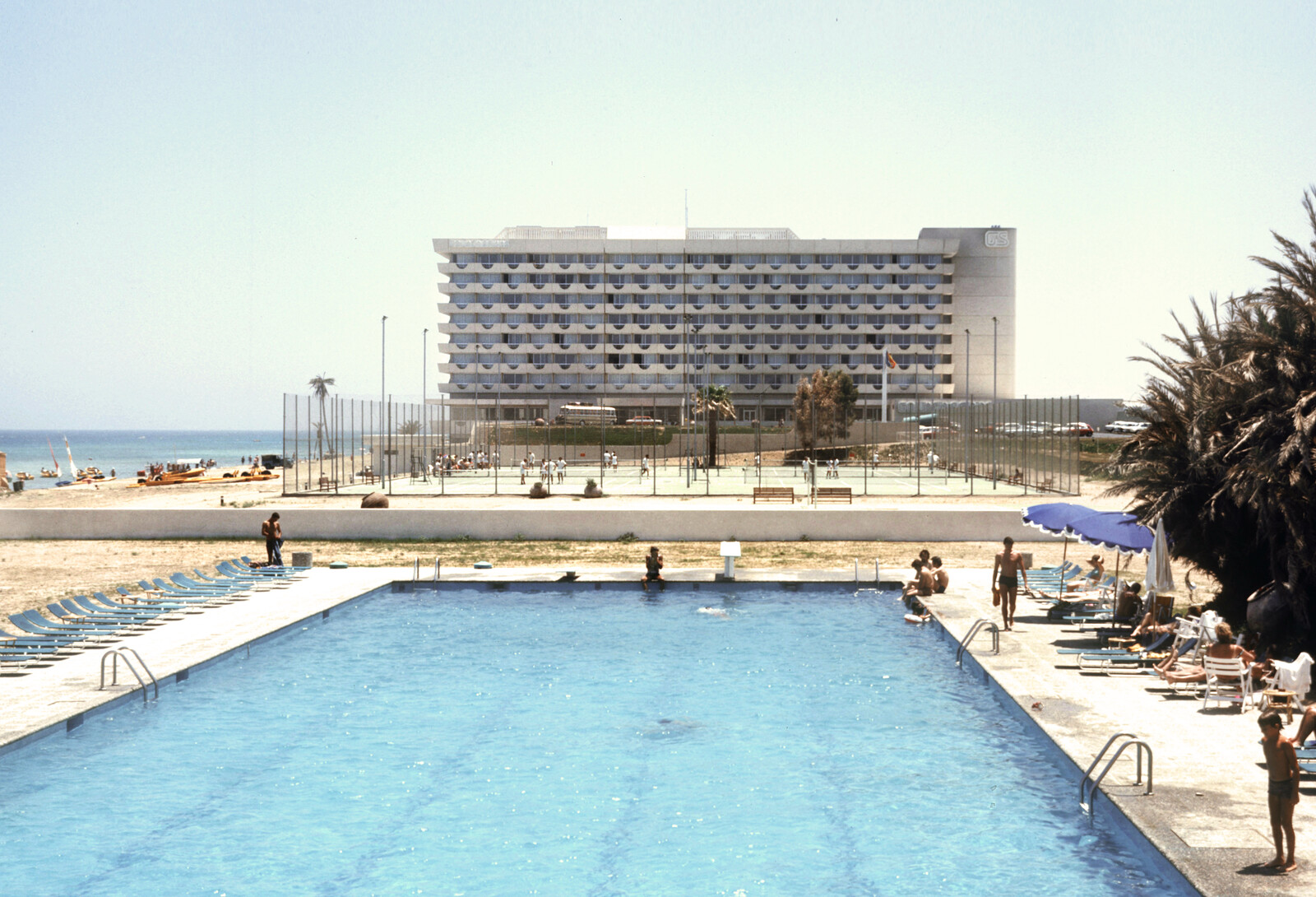
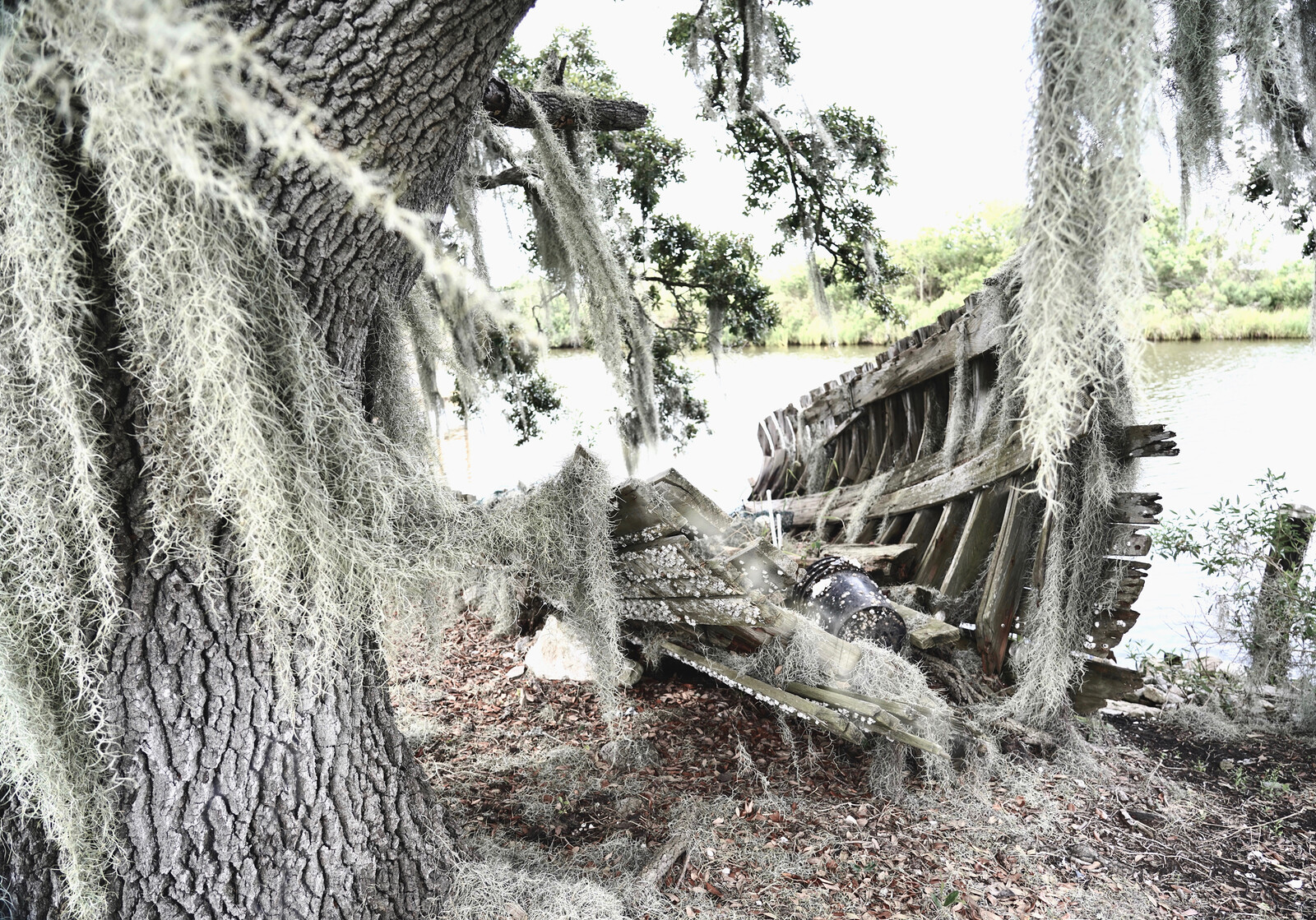

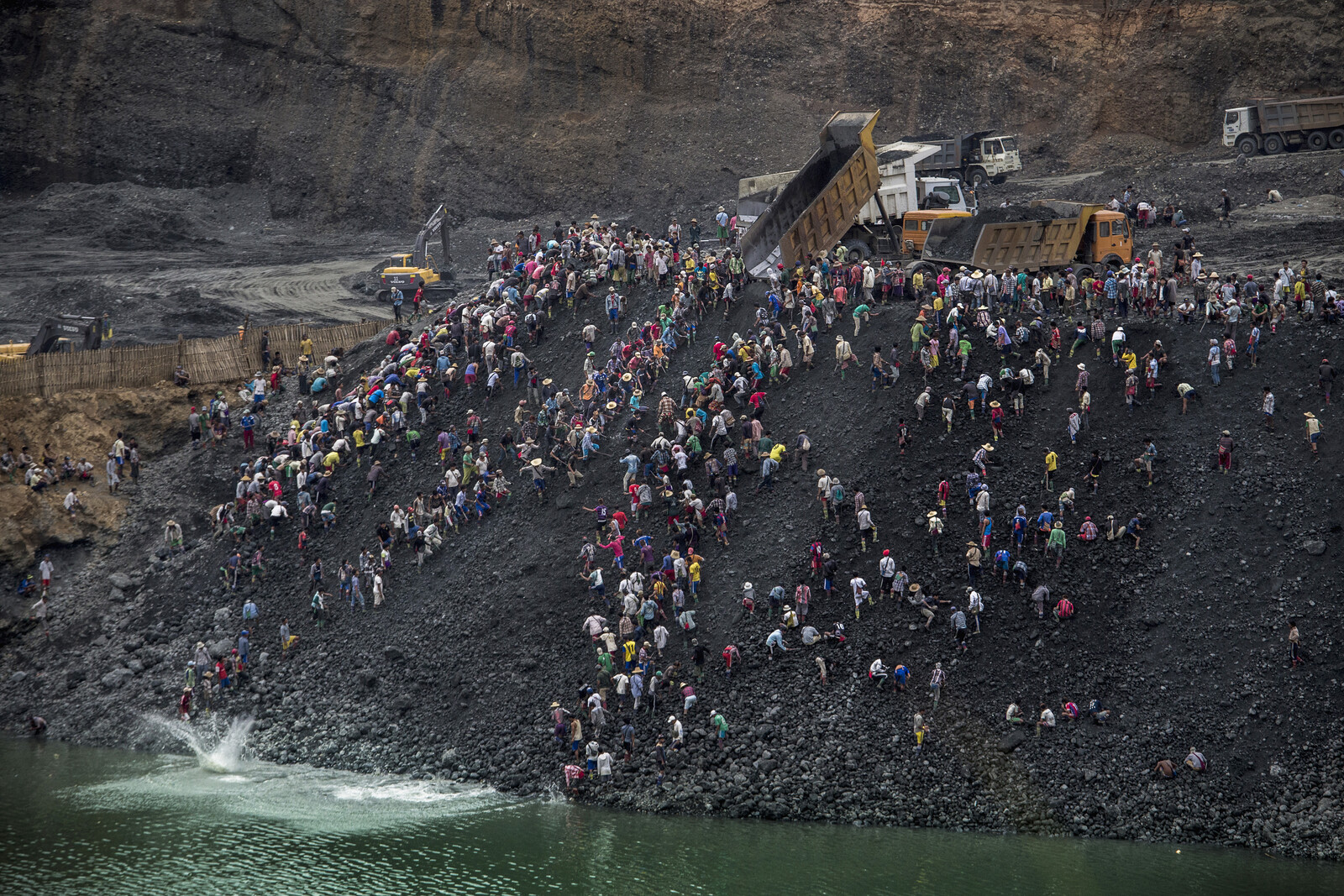
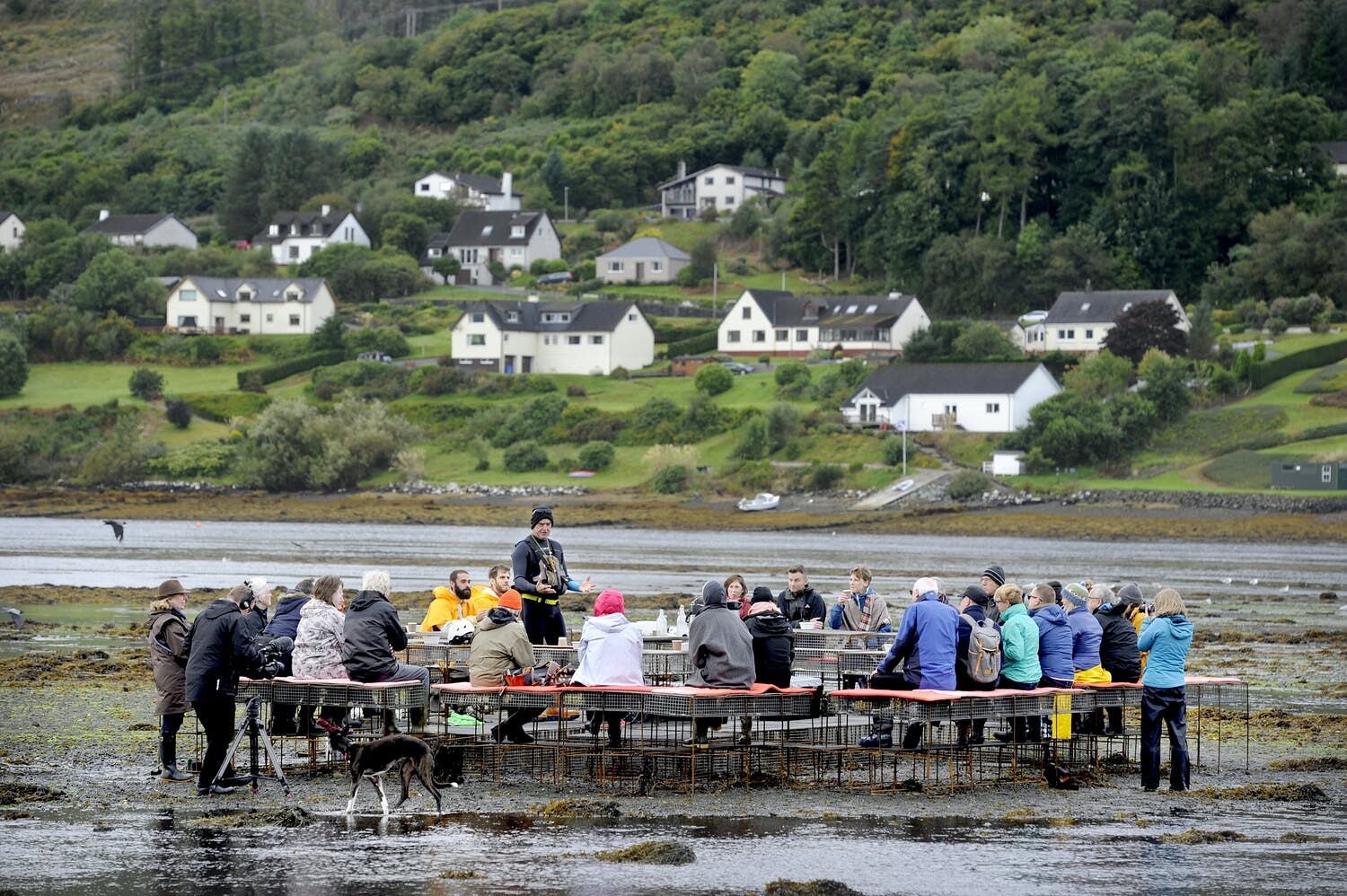
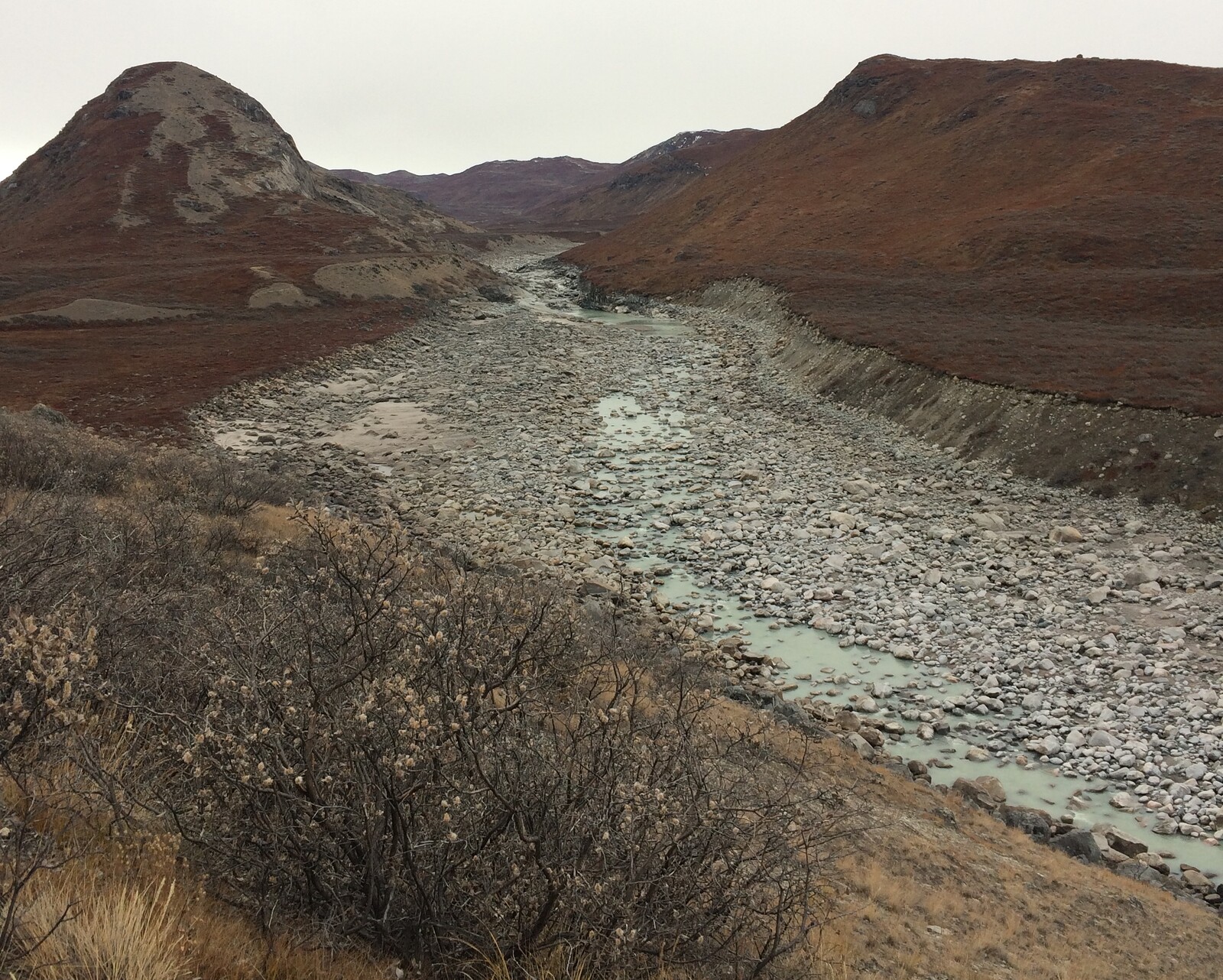
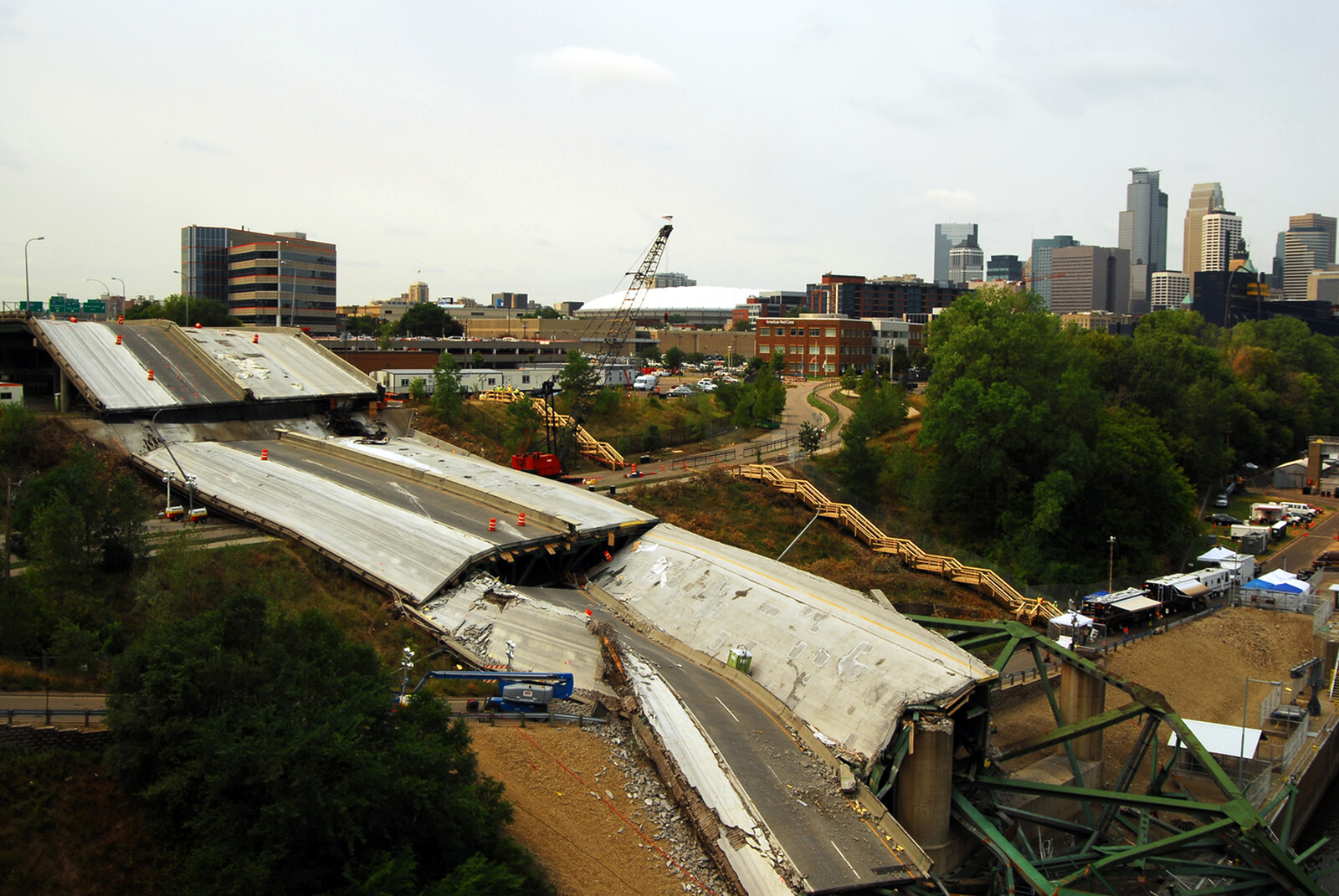
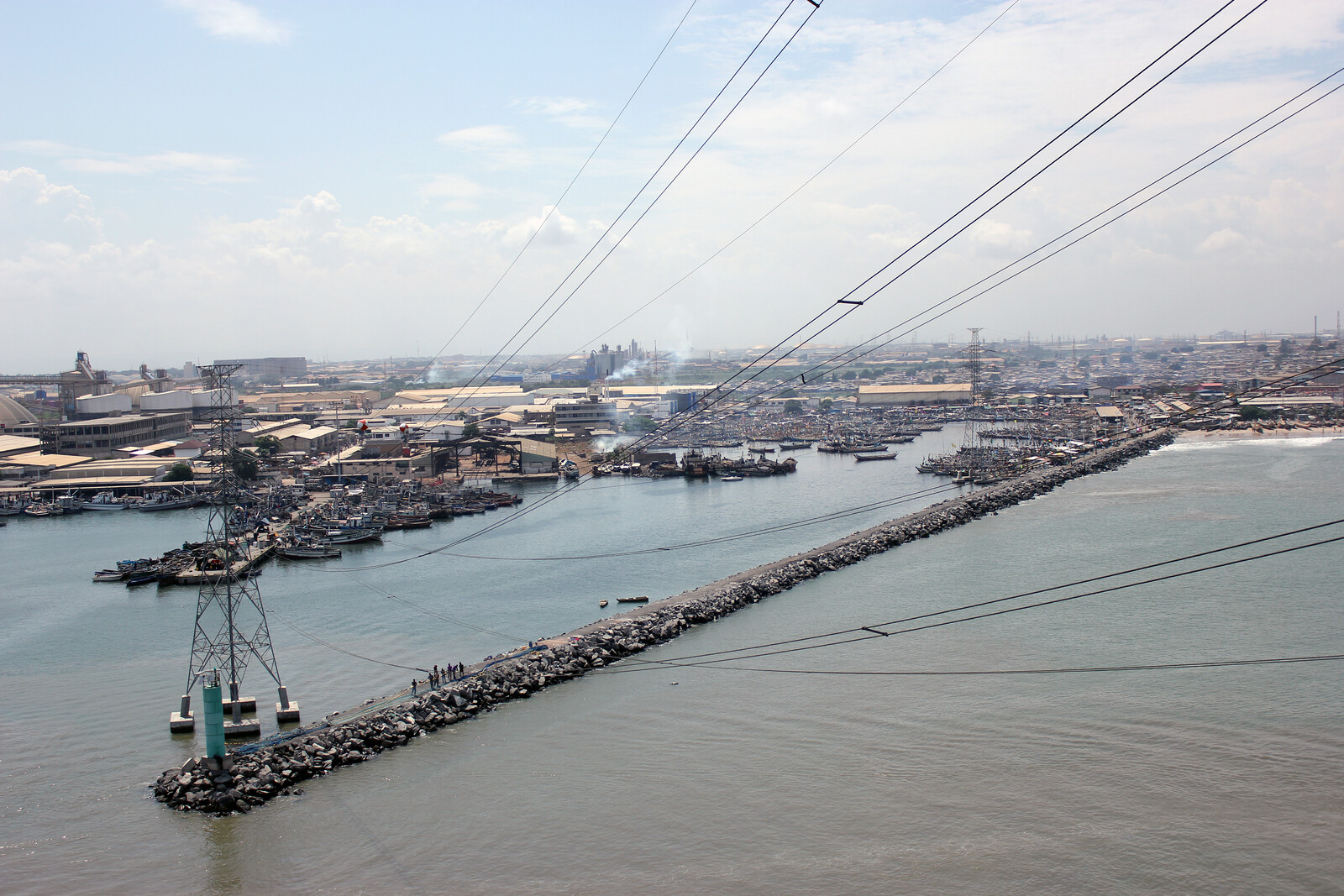
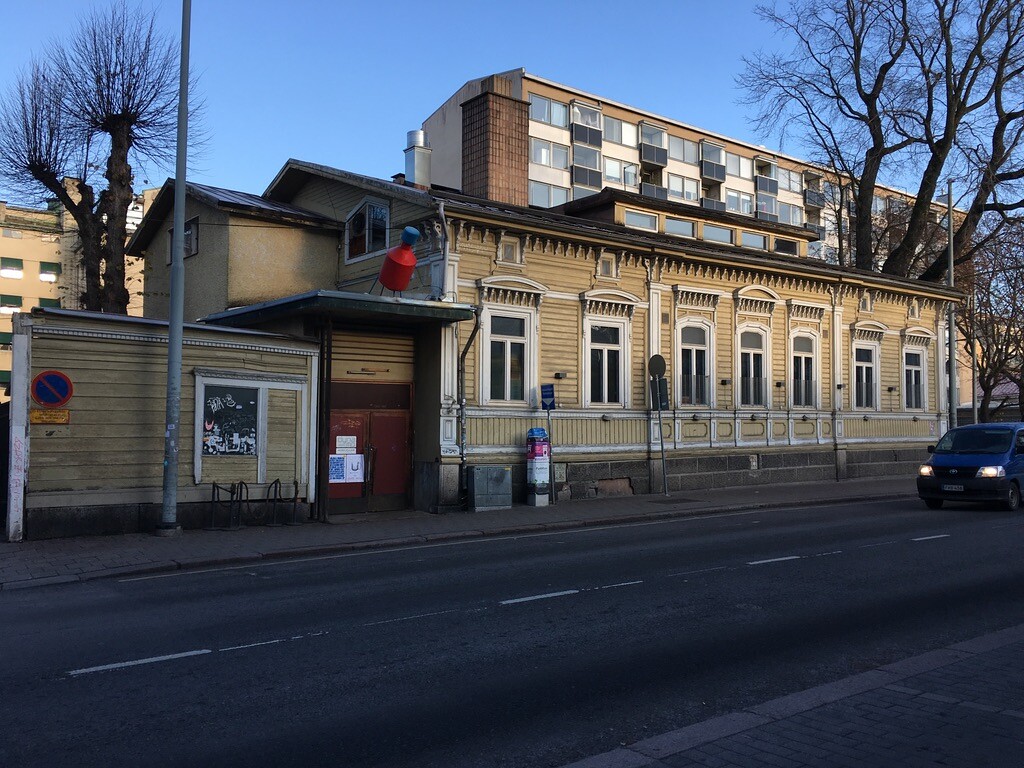

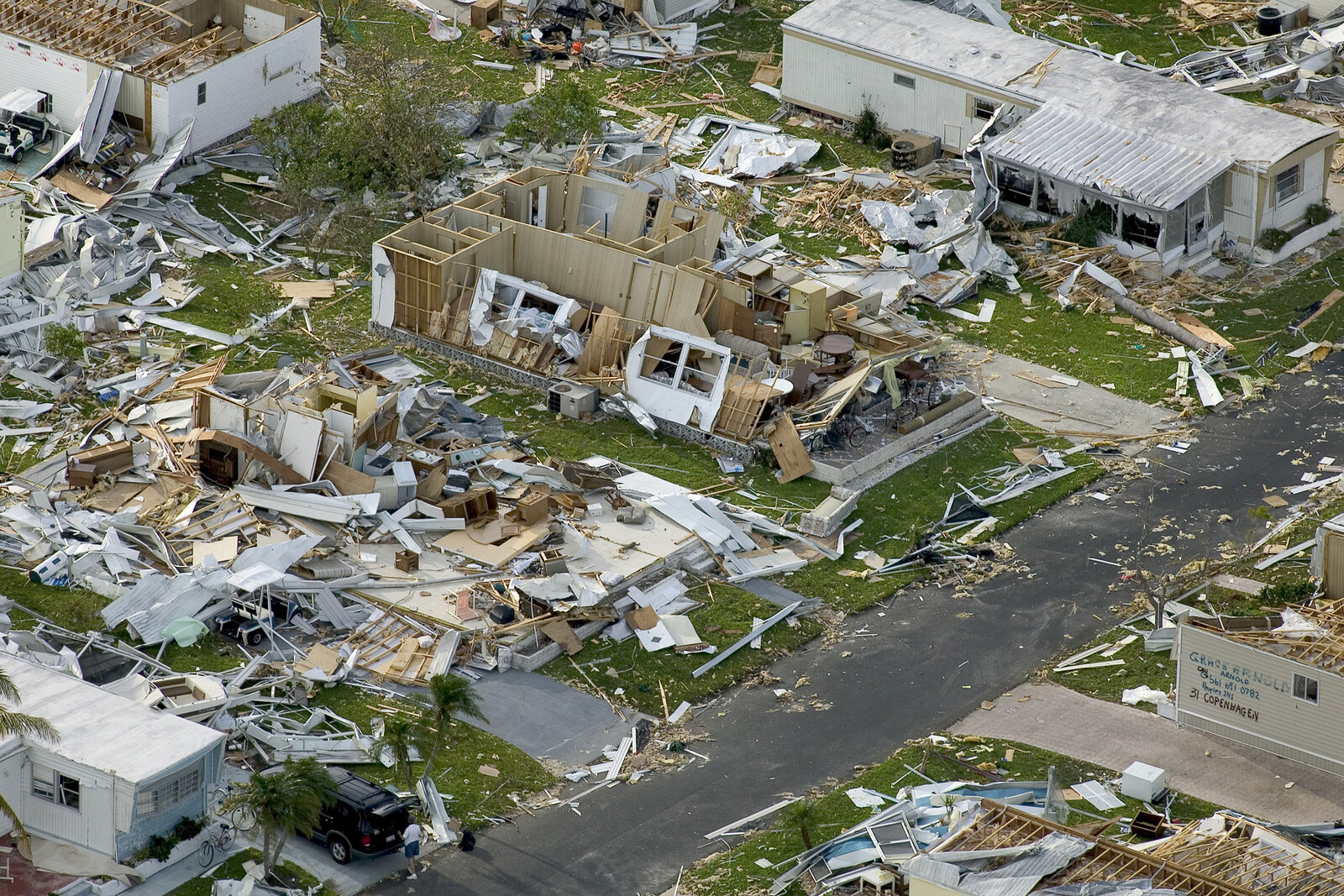
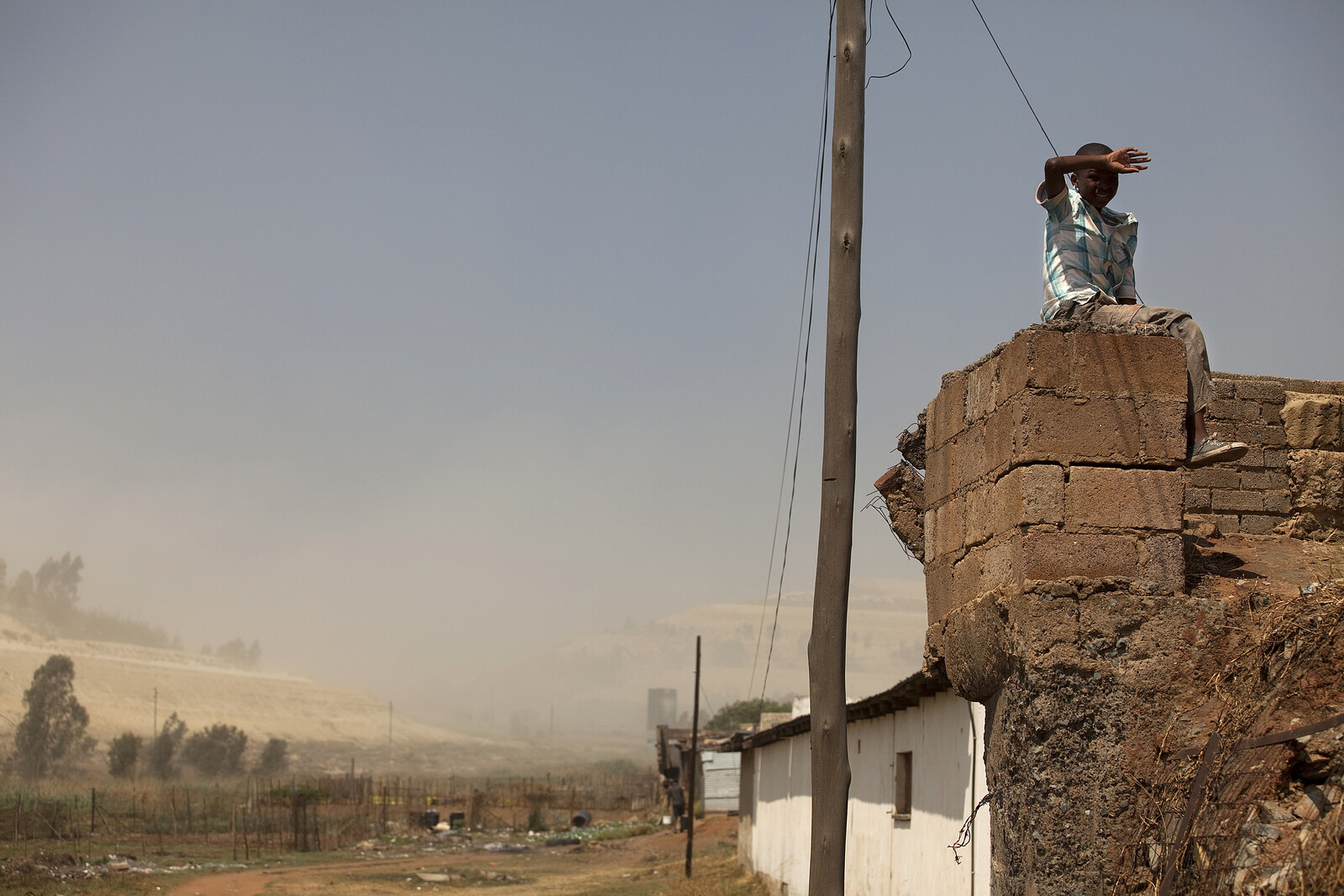
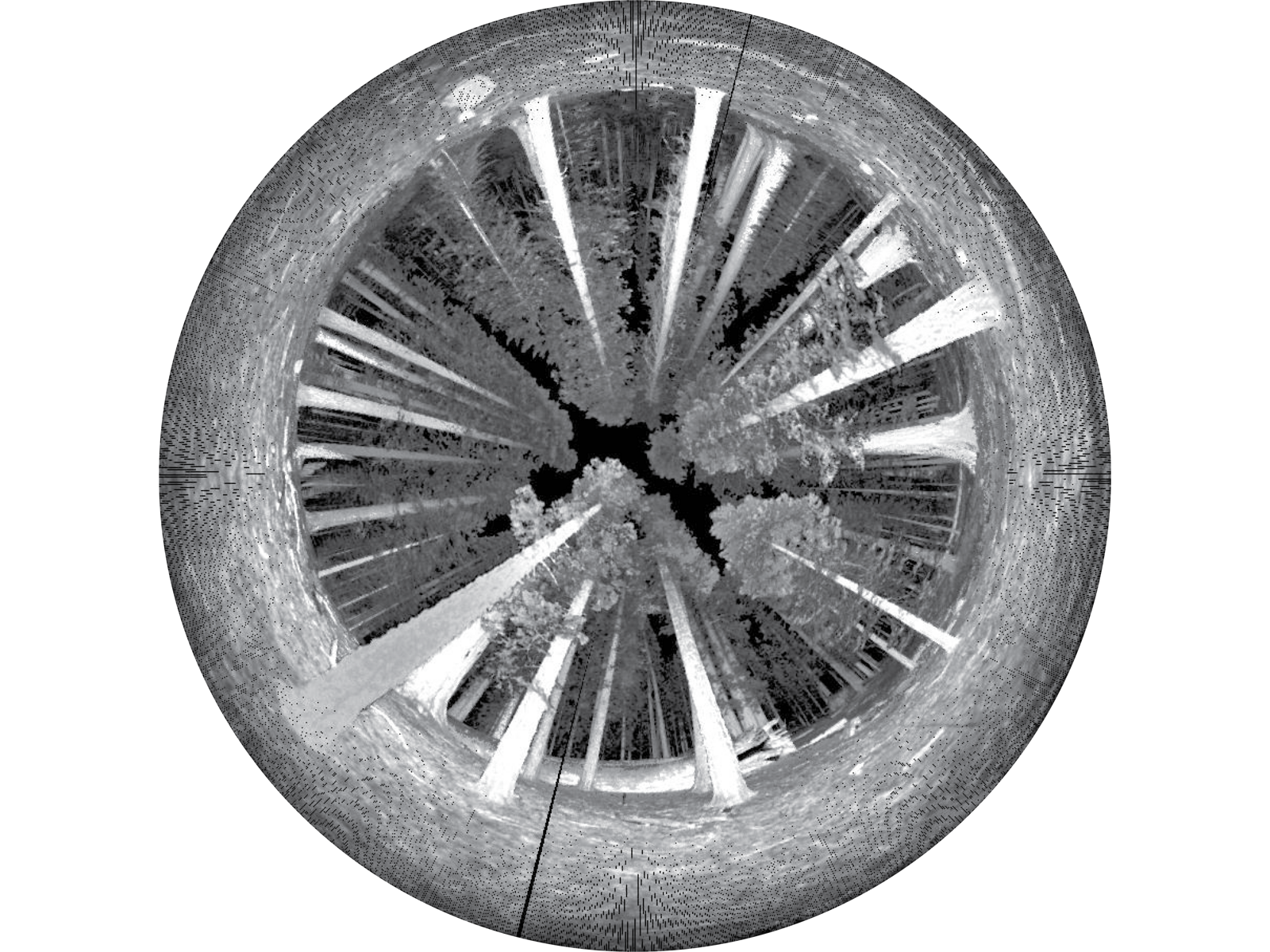
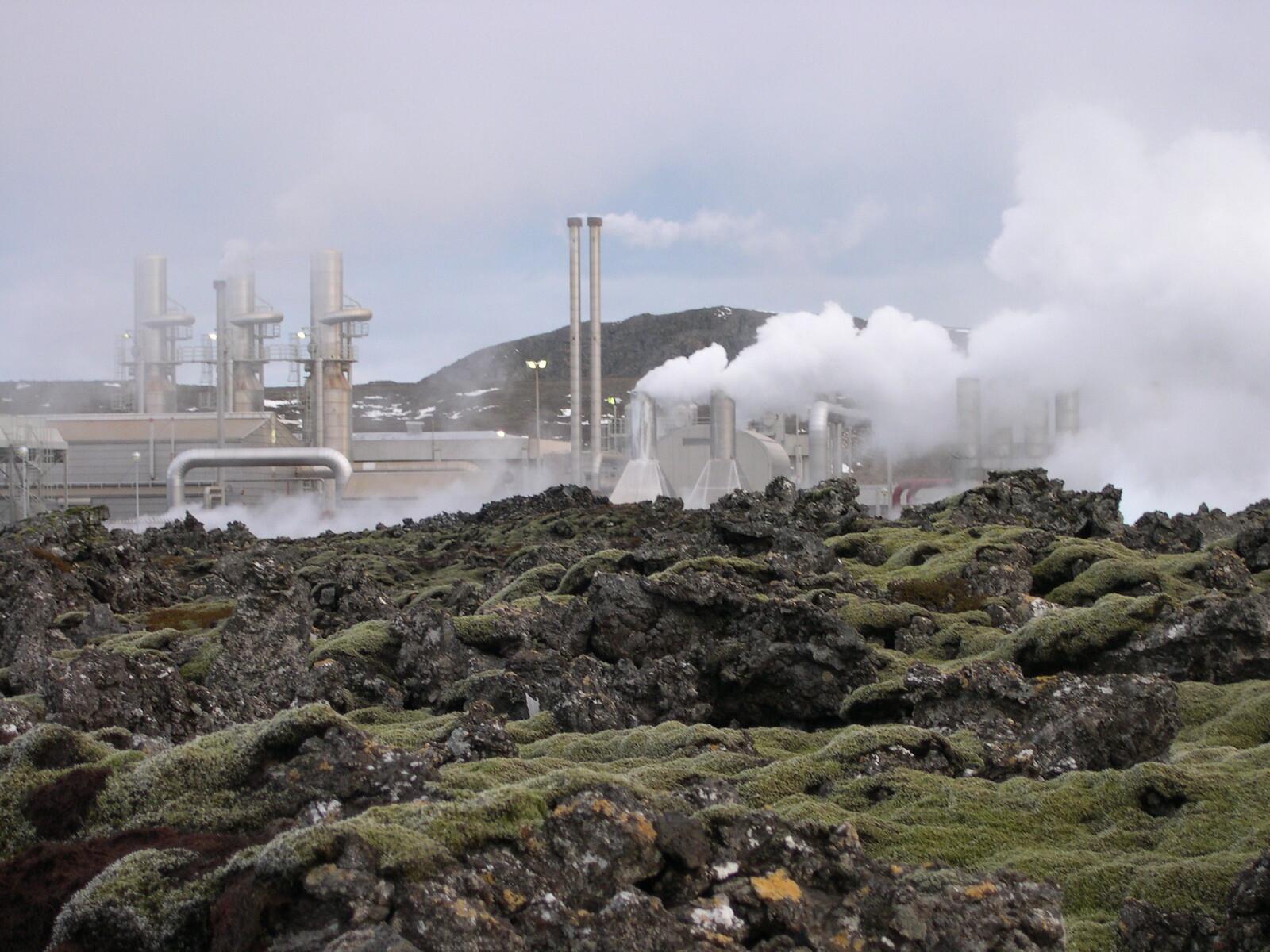
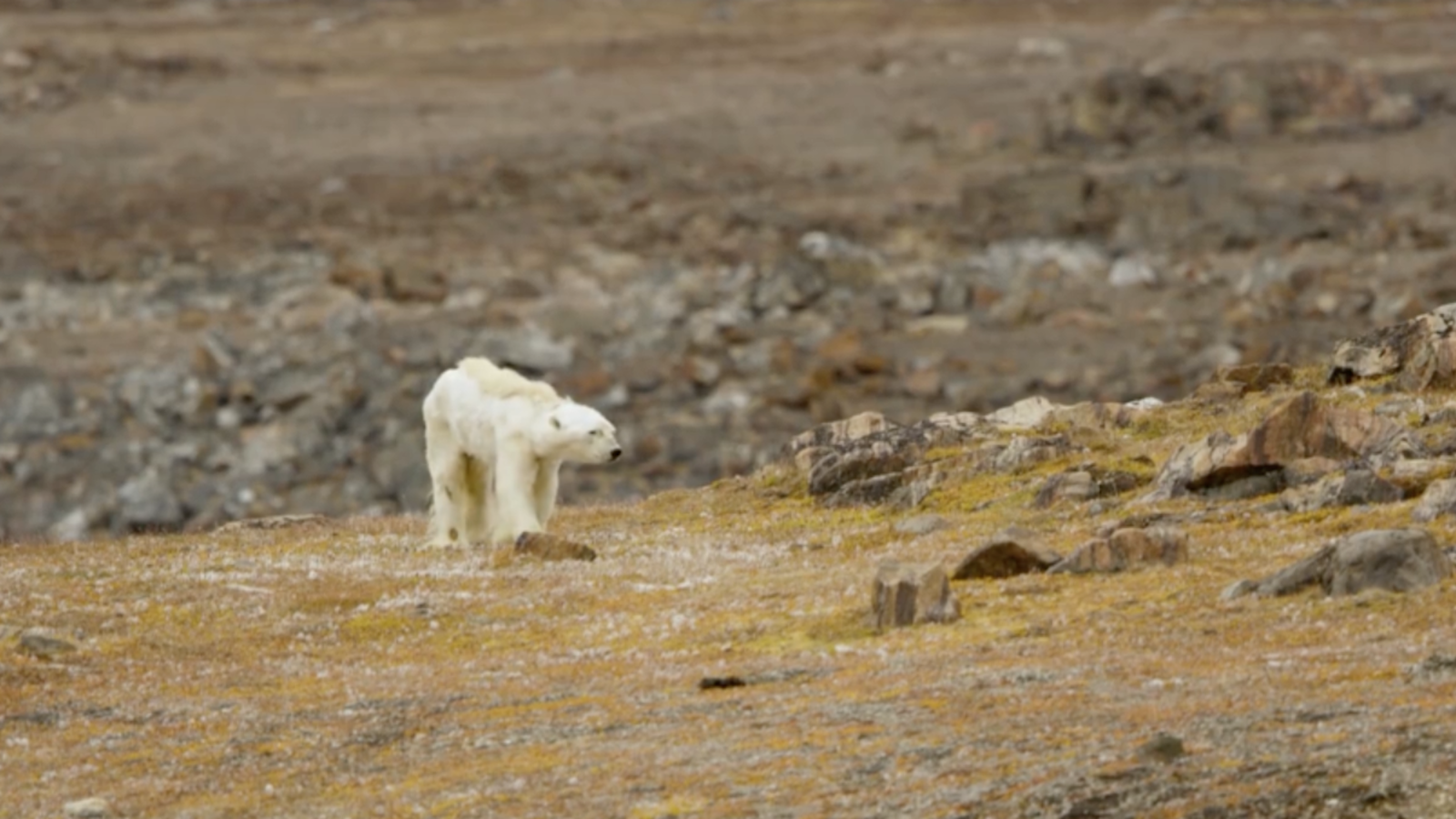
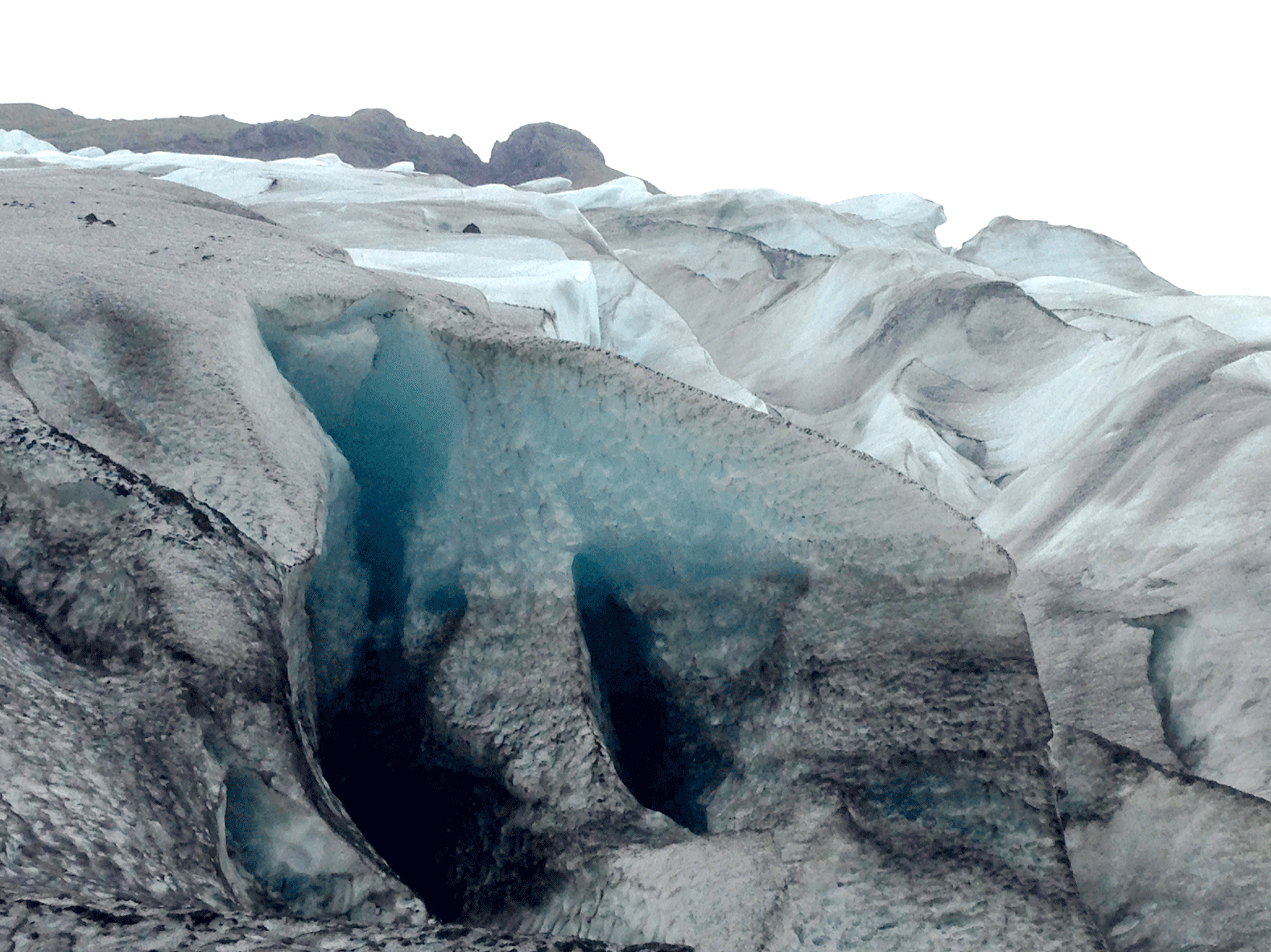
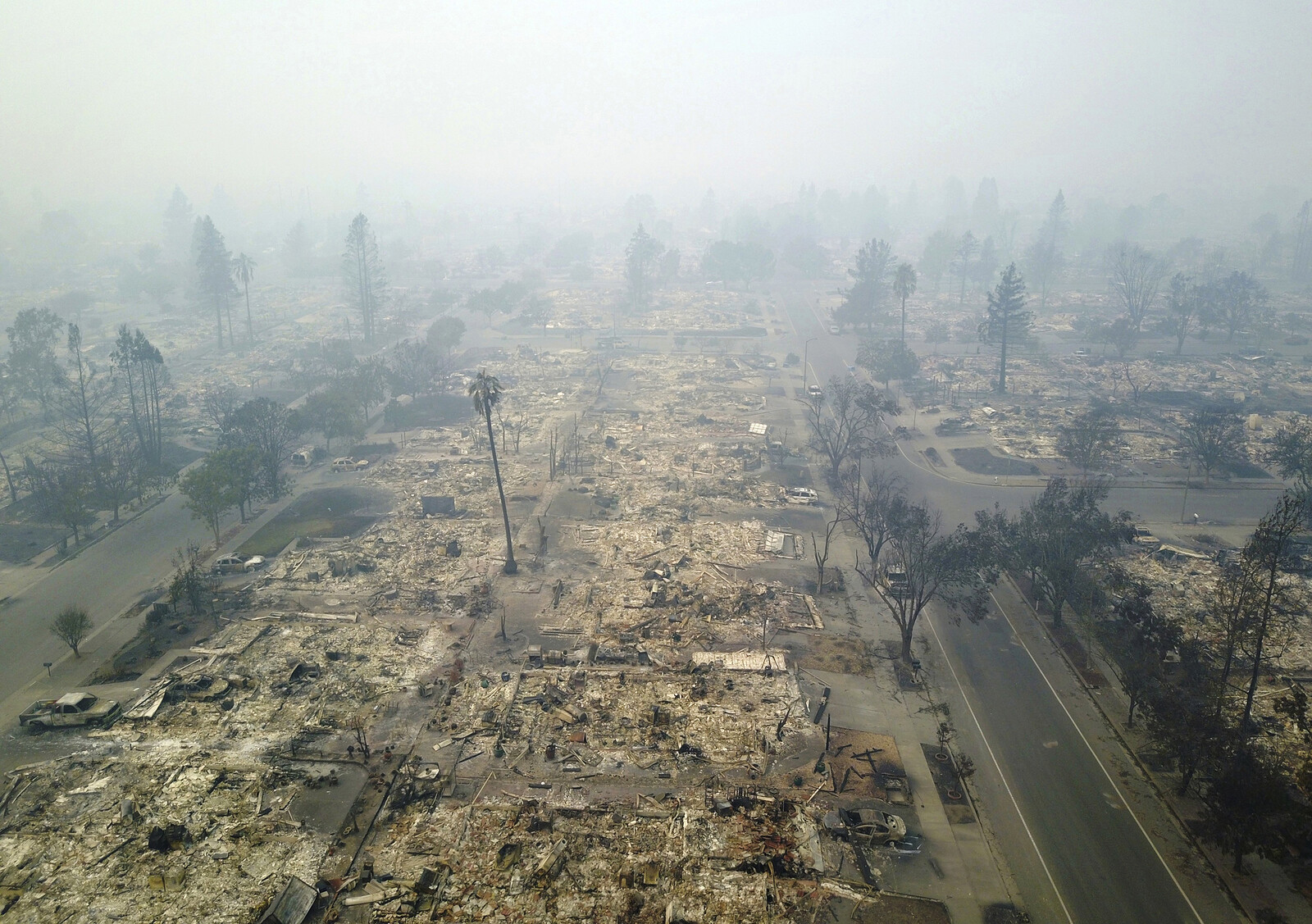
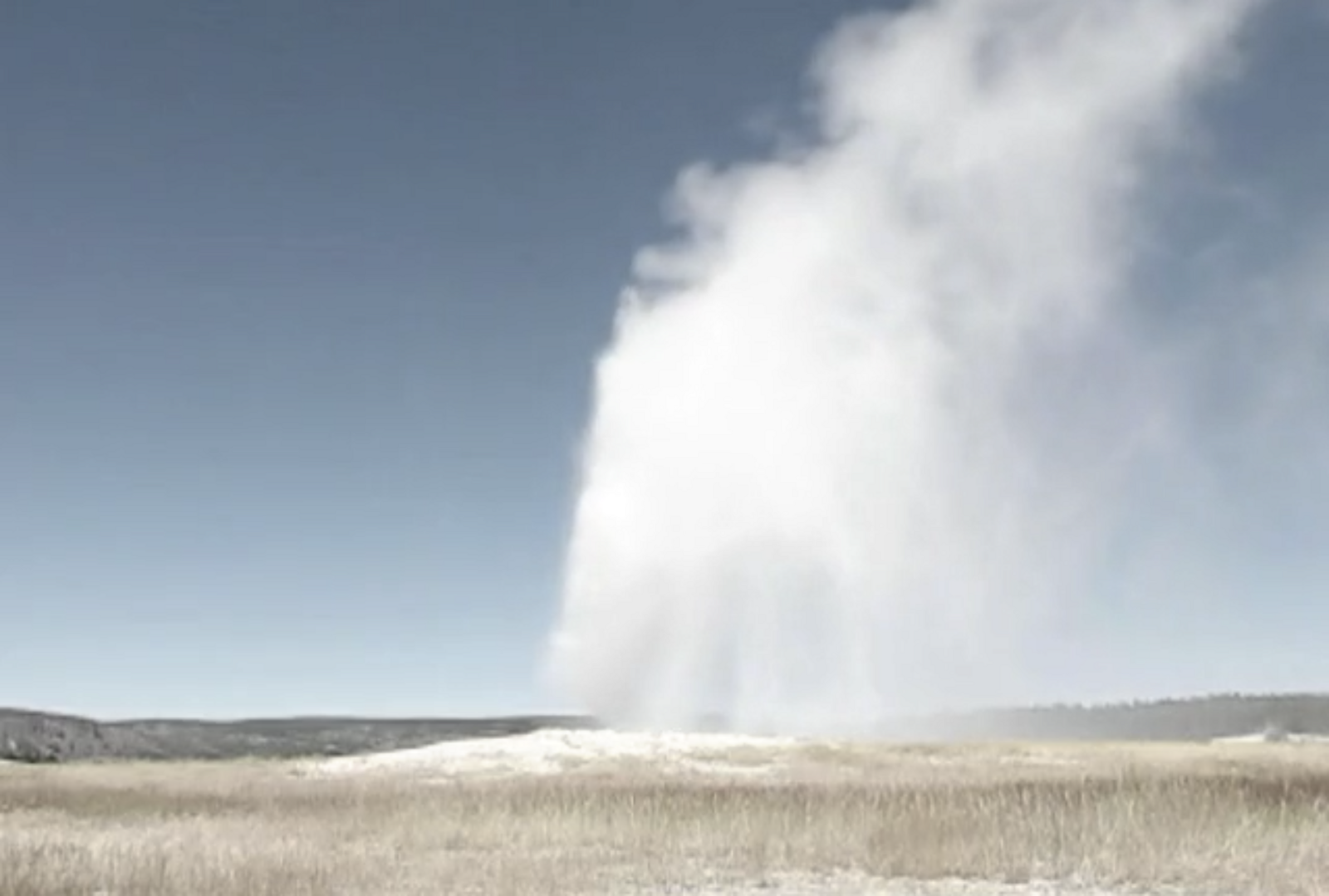
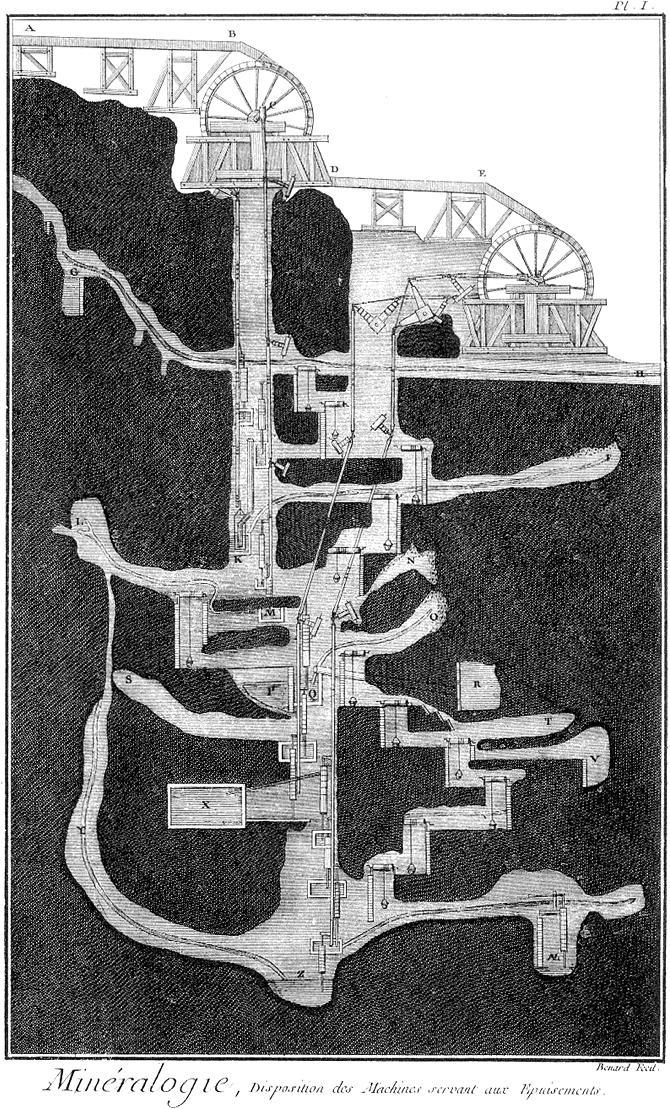

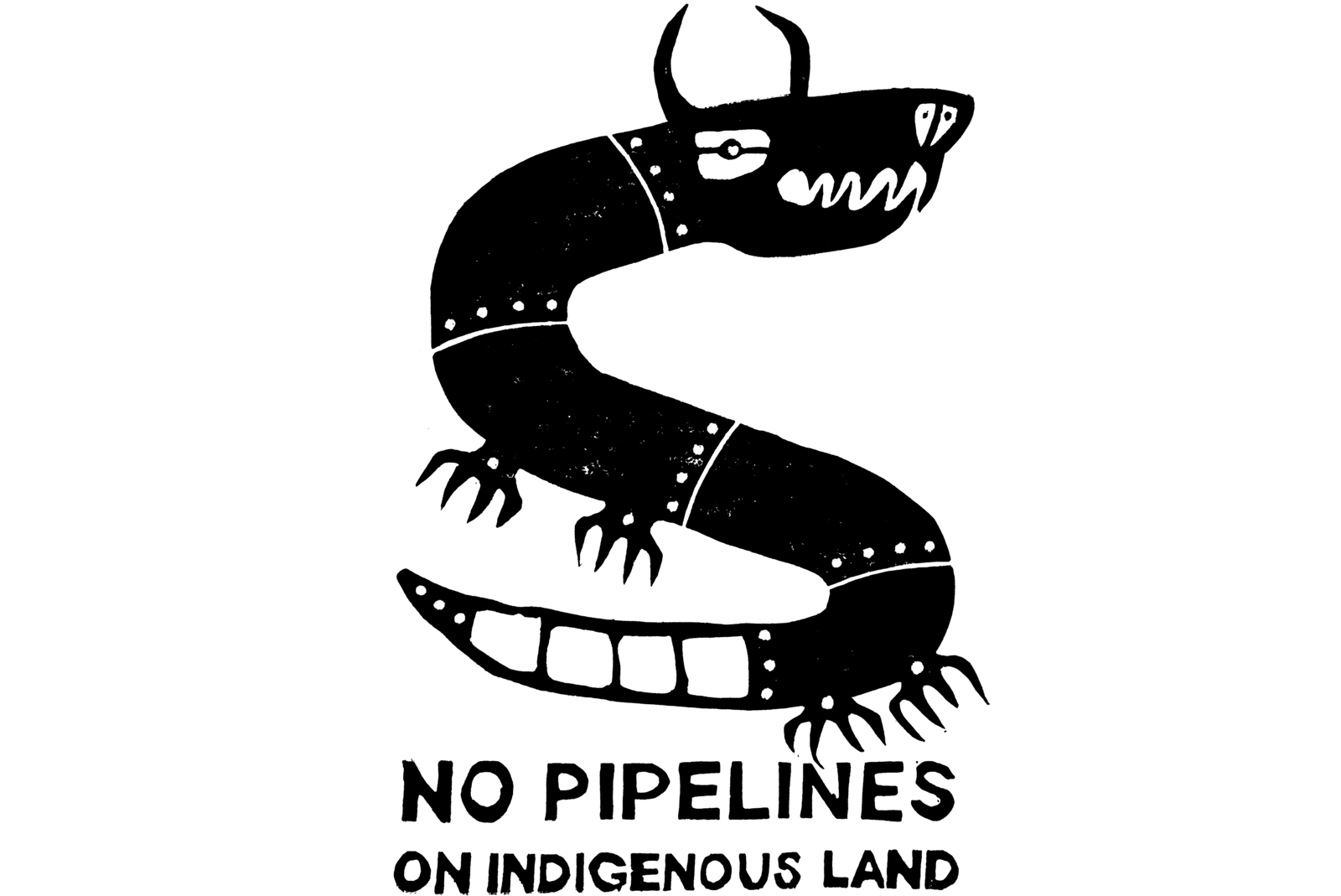
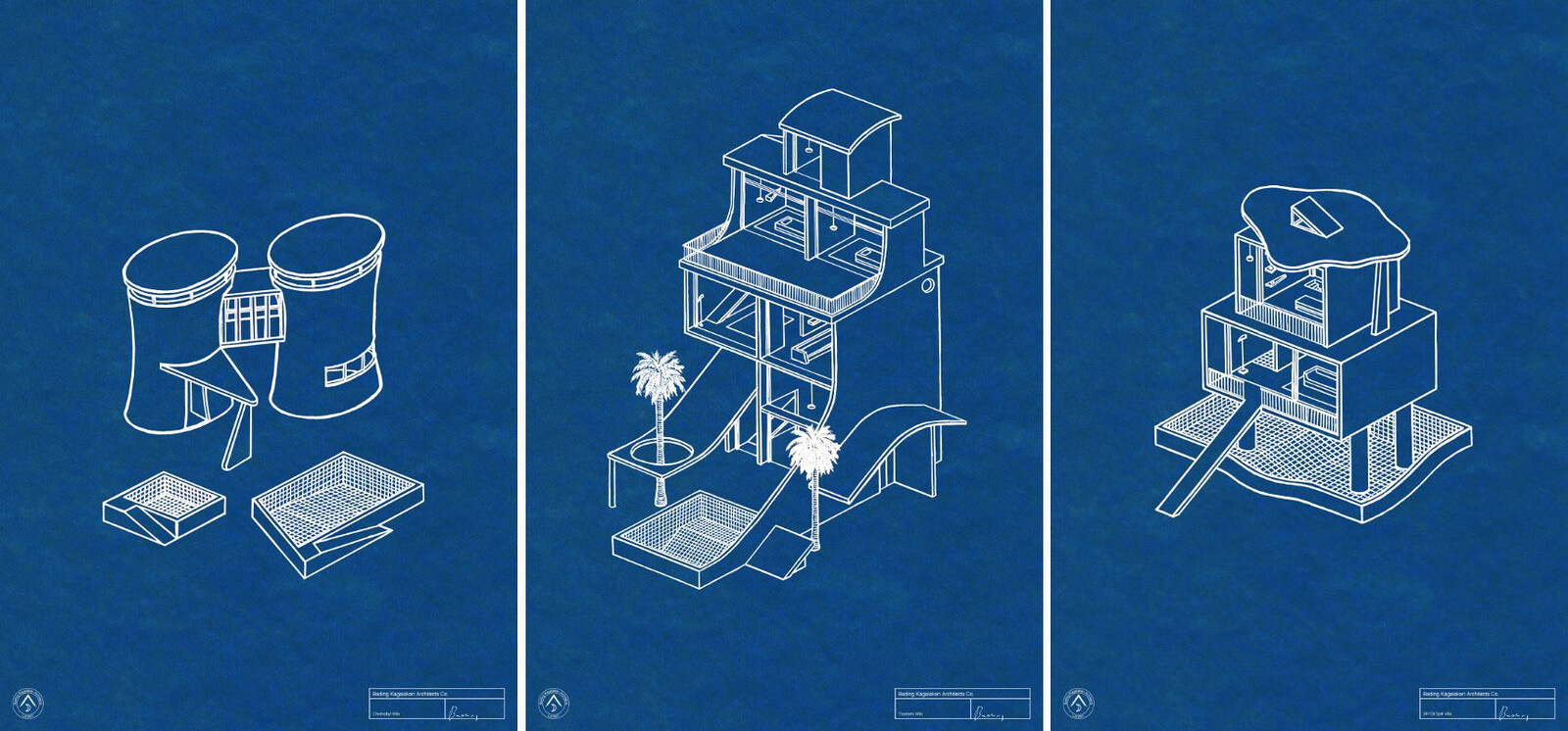
.png,1600)


